




PRESIDENT Dr. Irfaan Ali has reaffirmed the People’s Progressive Party/Civic (PPP/C)’s unwavering commitment to national development, urging citizens to once again entrust the government with the responsibility of steering Guyana towards a more sustainable and prosperous future.
Addressing a mammoth crowd of supporters and residents at a public meeting Monday evening in Enterprise, East Coast Demerara, the Head of State energised the gath-
ering with a comprehensive outline of the government’s vision and ongoing efforts to improve the quality of life across the country.
“We are asking you once again to give us that responsibility; to honour us with the responsibility to work for a better Guyana, a more progressive Guyana, a stronger Guyana, a wealthier Guyana, a healthier Guyana, a more educated Guyana, a more united Guyana,” the President declared.
Dr. Ali highlighted key achievements of the PPP/C
administration, including the removal of over 200 burdensome taxes, a significant reduction in non-performing loans, and the creation of 70,000 new jobs.
He noted that these efforts have contributed to Guyana now being recognised as the fastest-growing economy in the region, topping global rankings in mining, energy, and climate resilience.
The President further emphasised the government’s commitment to economic inclusion and resilience, addressing issues
such as the cost of living, home ownership, and access to essential services.
“We have a poverty reduction strategy that will seek to build an ecosystem in our country that will safeguard us from international pressure; the international pressure of rising food prices, the international pressure of rising energy costs, the international pressure of rising transportation costs, the international pressure from the consequences of wars and conflict, the international pressure on the healthcare system, the
international pressure on the education system,” the President stated.
He also reminded citizens of specific development plans for communities along the East Coast Demerara, including the establishment of a local feed production facility, and critical upgrades to community drainage infrastructure.
These projects form part of a broader drive to improve local livelihoods, and strengthen community resilience.
The President underscored the administration’s
long-term vision, pointing to forthcoming investments in infrastructure, education, and social services aimed at bridging divides, and building a more cohesive and inclusive society.
“We are not a seasonal party; our love is not seasonal. Our love is not only at election time.
The love of the PPP has endured on the side of the people for 75 years,” Dr. Ali said passionately, reinforcing the Party’s deep-rooted commitment to national progress.

THE U.S. could require bonds of up to $15,000 for some tourist and business visas under a pilot programme launching in two weeks, a government notice said on Monday, an effort that aims to crack down on visitors who overstay their visas.
The programme gives U.S. consular officers the discretion to impose bonds on visitors from countries with high rates of visa overstays, according to a Federal Register notice. Bonds could also be applied to people coming from countries where screening and vetting information is deemed insufficient, the notice said.
President Donald Trump has made cracking down on illegal immigra-
tion a focus of his presidency, boosting resources to secure the border and arresting people in the U.S. illegally.
He issued a travel ban in June that fully or partially blocks citizens of 19 nations from entering the U.S. on national security grounds.
Trump’s immigration policies have led some visitors to skip travel to the United States. Transatlantic airfares dropped to rates last seen before the COVID-19 pandemic in May and travel from Canada and Mexico to the U.S. fell by 20% year-over-year.
Effective August 20, the new visa programme will last for approximately a year, the government notice said. Consular officers

will have three options for visa applicants subjected to the bonds: $5,000, $10,000 or $15,000, but will generally be expected to require at least $10,000, it said.
The funds will be returned to travellers if they depart in accordance with the terms of their visas, the notice said.
A similar pilot programme was launched in November 2020 during the last months of Trump’s first term in office, but it was not fully implemented due to the drop in global travel associated with the pandemic, the notice said.
The State Department was unable to estimate the number of visa applicants who could be affected by the change. Many of the countries targeted by
Trump’s travel ban also have high rates of visa overstays, including Chad, Eritrea, Haiti, Myanmar and Yemen.
Numerous countries in Africa, including Burundi, Djibouti and Togo also had high overstay rates, according to U.S. Customs and Border Protection data from fiscal year 2023.
A provision in a sweeping spending package passed in the Republican-controlled U.S. Congress in July also created a $250 “visa integrity fee” for anyone approved for a non-immigrant visa that could potentially be reimbursable for those who comply with visa rules.
The $250 fee goes into effect on October 1. (Reuters)


NBS closes accounts of persons associated with US-sanctioned Mohamed’s WIN
THE New Building Society (NBS) has begun severing ties with candidates of US-sanctioned Azruddin Mohamed’s political party, We Invest in Nationhood (WIN), joining three other banks that have taken similar action recently.
The Guyana Chronicle was reliably informed that these steps are in keeping with the banks’ standard risk assessment procedures under the Anti-Money Laundering and Countering the Financing of Terrorism (AML/CFT) laws.
This newspaper was made to understand that the accounts of 12 persons attached to WIN, one of whom is a U.S citizen who has been leading the party’s campaign, were closed.
Citizens Bank, the Guyana Bank for Trade and Industry (GBTI) and Demerara Bank have all closed the personal accounts of several WIN candidates.
WIN candidates Natasha Singh-Lewis and Duarte Hetsberger had previously confirmed they both received letters from a bank stating that the decision stems from an internal policy of the banking institution.
In August last year, the Bank of Guyana confirmed that all banks in Guyana had closed accounts they had with the Mohamed family and their businesses fol -
lowing U.S. sanctions for their alleged roles in public corruption.
Azruddin, along with his father, Nazar Mohamed and their businesses, namely Mohamed’s Enterprise, Hadi’s World and Team Mohamed’s Racing, on June 11, 2024, were sanctioned by the U.S. Department of the Treasury’s Office of Foreign Assets Control (OFAC), which oversees sanctions against

individuals and entities tied to illicit activities and hostile foreign governments.
In a June 2024 statement, the OFAC stated, “Azruddin and Mohamed’s Enterprise evaded Guyana’s tax on gold exports and defrauded the Guyanese government of tax revenues by under-declaring their gold exports to Guyanese authorities.
Between 2019 and 2023, Mohamed’s Enterprise omitted more than 10 thousand kilogrammes of gold from import-and-export declarations and avoided paying more than US$50 million in duty taxes to the Government of Guyana.”
–– VP Jagdeo says round.
DECLARING that Guyana needs to create a culture of intolerance against violence, especially against women and children, the government has pledged tougher enforcement and greater police accountability as part of a comprehensive plan to clamp down on sexual and domestic violence.
Vice-President Dr. Bharrat Jagdeo during a Monday afternoon radio programme, said that laws are not enough to tackle these pertinent issues of violence, but the police should do more.
The Vice-President said, “I’ve seen many cases where the police don’t
pay enough attention to the matter. They don’t take it seriously and we need to have greater police accountability.”
There will be expanded support to deal with violence, as the Vice-President said that everyone will be on board, including non-governmental and religious organisations.
Already, the government has increased the subvention to NGOs that deal with abuse against children, enacted stricter laws and strengthened the Child Protection Agency. He also called for a culture change, noting that the issue of violence is a societal problem that needs intolerance all-
He said: “We need to work more on a culture of intolerance, and women need to have a support system because many of them depend on the guy, for financial support… so they then have to go back to him. That is why we need to create more avenues for employment, etc.”
This complex issue, he said, plagues different aspects of society and often many become numb to this and therefore, it is important to foster this intolerance for violence.
Last week, the Vice-President said that the government will continue to put more resources out so that there can be 24-hour monitoring.
“Our women and chil-
dren must be safe. That’s how we intend to approach it,” he said.
The Vice-President’s comments come on the heels of numerous disturbing cases in Guyana, where women were killed by their partners, ex-partners, and in one case, a young woman was allegedly murdered by her stepfather, while another case involved the murder of a woman during a robbery.
Some other victims that have tragically died recently are: Maline LaCruz, Waveney LaCruz, SueAnn LaCruz, Marissa Beete, Kenesha Vaughn, Shameeza Mohamed, Parbhudai Boodram, Bibi Fazila Ally, Mezona Ronaldo and Althea Walton.



CONDOLENCES poured in for head teacher of the Three Mile Secondary School, Daniel Williams who died on Monday.
“It is with deep sadness and profound shock that the People’s Progressive Party/Civic (PPP/C) mourns the sudden passing of Mr. Daniel Williams, head teacher of

Three Mile Secondary School in Bartica and a candidate of the PPP/C for the upcoming elections,” the party said in a post on its Facebook page.
Williams collapsed while addressing a public meeting in Agatash, Region Seven (Cuyuni-Mazaruni), and was later pronounced dead by medical authorities.
“Daniel was an educator and community leader whose unwavering dedication to improving the lives of those around him will be remembered by all who had the honour of knowing him.
We extend our deepest condolences to his family, friends, students, colleagues, and the residents of Region Seven.
Our Party has lost a valuable comrade, and our nation has lost a true servant,” the PPP/C said.


REGION 10, known as the heart of opposition politics in Guyana, saw something remarkable on Sunday evening.
A sea of red filled Lieu-Ken-Pen Square in Wismar as President, Dr Mohamed Irfaan Ali presented what can be called the most detailed development plan any government has ever put forward for this region.
For years, residents of Linden have heard empty promises during election campaigns. Then, they watched their communities decline under the coalition that took their votes for granted. What sets President Ali’s speech apart is the solid track record of progress that has already changed the region significantly.
The difference is striking. The previous APNU+AFC administration had allocated only $4.2 billion for Region 10’s development over five years. In contrast, the
current PPP/C government has invested an impressive $122.6 billion, a 29-fold increase that highlights a true commitment versus mere promises. This isn’t just election talk; it’s a pattern of prioritising people over politics.
President Ali’s plan to revamp the drainage system tackles one of Region 10’s biggest problems—flooding in areas such as Wismar and Mackenzie. This is more than just another infrastructure promise. The government has already spent over $1.5 billion on drainage projects from 2020 to 2024. This shows that when the PPP/C promises something, they deliver real results.
The planned airstrip improvements, tourism incentives, and efforts to make Region 10 an economic hub go beyond development initiatives—they represent a major shift in how the region fits into Guyana’s national development strategy.
Linden will no longer be overlooked; it will lead economic growth.
What makes this development agenda especially compelling is its thoroughness.
The $35 million Mackenzie-Wismar Bridge is already being built, alongside plans for a $30 million hospital upgrade.
Local jobs will come from constructing drains and financial services will expand for riverine communities—every aspect of daily life is being considered.
The President’s commitment to assess and prioritise “every village in Region 10” shows a level of detailed planning that goes beyond standard campaign talk. This is governance through engagement, not by guesswork.
Critics might wonder if the PPP/C can keep these ambitious promises, but the proof is evident on the streets of Linden. In just two years, over $18 billion has gone
into road improvements, employing 700 local contractors, and creating thousands of jobs through infrastructural projects—these are not future promises but current realities.
The transformation of Region 10 under the PPP/C represents more than just regional development—it shows that effective governance goes beyond traditional political lines. When a government delivers results instead of words and invests in communities instead of just constituencies, it earns the right to ask for continued trust.
President Ali’s message to voters in Region 10 is clear: Judge us by our actions, not our words.
In a political landscape often filled with empty promises and divisive speech, the PPP/C’s achievements in Region 10 provide strong evidence that real change happens when commitment meets capability.
Dear Editor,
AS the Chairperson of the Ambassadorial Working Group within the fraternity of the Organisation of African, Caribbean and Pacific States (OACPS) on International Tax Governance and Anti-Money Laundering/Countering the Financing of Terrorism (AML/CFT), I would like to note the editorial published in Kaieteur News on 28 July, 2025, titled, “Bank Action – the Question Before Guyanese,” and make the following statement.
“Given the sensitive nature of the subject matter and the complexity of the international financial regulatory environment, I wish to offer some clarifying context, drawn from collective experiences and ongoing dialogue between the OACPS and international bodies such as the European Union, the Financial Action Task Force (FATF), and the OECD.
While I will refrain from commenting on the specific case referenced in the editorial, it is important to frame this discussion within the broader legal and regulatory framework that governs financial institutions in Guyana and by extension, globally.
Matters involving banking relationships—especially account closures—must be assessed through the lens of regulatory compliance, risk management and the overarching objective of preserving the integrity of a nation’s financial system.
Guyana’s financial institutions operate
within a regulated environment under the Laws of Guyana, which align with international financial standards.
These include requirements on customer due diligence and Know Your Customer (KYC) procedures, which are central to both domestic law and global AML/CFT protocols.
KYC measures serve to safeguard not only the institution in question, but all customers of a licensed financial institution, such as a commercial bank. Their purpose is to enhance transparency and good governance over the depositors’ funds, mitigate financial crime and maintain the trust necessary for financial systems to function effectively.
Guyana, like its sister nations, does not operate in isolation; its financial ecosystem is part of a globally interconnected framework. Departing from these obligations would not only risk reputational harm, but could also threaten access to international financial systems and instruments.
There are consequences for any state whose action, intentionally or unintentionally, destabilises the global financial system.
As Guyana’s economy grows and becomes increasingly integrated into the global market, its financial institutions face greater visibility and corresponding responsibility.
In this context, international standards— such as those developed by the Basel Committee on Banking Supervision and the FATF—impose obligations to implement comprehensive, risk-based approaches to
customer verification and transaction monitoring, especially on those classified as PEPs (Politically Exposed Persons) and their close associates.
Enhanced due diligence is essential for individuals maintaining large account balances, persons who are classified as PEPs, and their close associates.
Therefore, by local legal obligations, all licensed financial institutions in Guyana must report any deficiencies or concerns discovered about KYC documentation to the Financial Intelligence Unit and the Bank of Guyana. Failure to do so may attract regulatory consequences.
Section 33 of the Financial Institutions Act (1995) empowers the Bank of Guyana to act where a licensed financial institution is engaged in, or is about to engage in, practices deemed unsafe, unsound, or in violation of applicable laws and regulations.
Section 11 of the same Act further empowers the Central Bank to revoke the licence of a financial institution that fails to comply with its legal obligations after being given a reasonable opportunity to rectify any shortcomings. Such directives are not optional -- they are binding.
Account closures are legal and regulatory tools available to financial institutions where risk mitigation necessitates such action. It would, therefore, be misleading and unhelpful to frame such decisions as personal or arbitrary.
Banks must safeguard the integrity of their internal control systems and the interests of the wider customer base. The whole is always more important than the part when it comes to the financial system.
Indeed, the closure of accounts—even those belonging to diplomatic missions—has occurred in other jurisdictions, including within the European Union. These actions are taken in adherence to international standards and in compliance with national regulatory frameworks—not as punitive measures, but as necessary steps to preserve the integrity of the national financial system.
In conclusion, sound risk management and regulatory compliance are fundamental to the safety and soundness of a nation’s financial system. When a financial institution determines that maintaining a banking relationship may pose a risk to that system, it is not only within its rights but in fulfilment of its obligations to take appropriate action. The national interest—and the integrity of the financial system—must remain paramount.
Yours truly, H.E. Sasenarine Singh Ambassador of Guyana to the Kingdom of Belgium and Netherlands, Permanent Representative to the European Union and Permanent Representative to the Organisation of African, Caribbean and Pacific States
THERE are two perennial anti-government actors that are relentless in their anti-PPP and anti-government stances.
I have covered the reason for that political insanity in dozens of columns, particularly from 2023, so that analysis need not be repeated here; sufficeth to say class and race have determined and motivated the frenetic anti-government obsession of these two actors.
They are the General-Secretary (GS) of the Guyana Trade Union Congress (TUC), Lincoln Lewis and the Mulatto/Creole business newspaper, the Stabroek News (SN). I repeat the word, “relentless” in their incessant condemnation of both the organisations named the People’s Progressive Party and the Government of Guyana (GoG).
SN is at it every day. The only manifestation of hate left to be seen is SN openly saying that the PPP should go away forever from Guyana. Lincoln Lewis has been the GS of the TUC for 32 years now.
If ever there is a one-man army in Guyana, it is Lewis. He is the GTUC and the GTUC is Lewis. He is the Critchlow Labour College (CLC) and the CLC is Lewis.
Lewis writes a letter every week against the government and he has a weekly column in an online newsletter, “Village Voice,” for which he was taken to the court for copyright infringement and lost. Lewis was charged for assaulting a woman and appeared at the Mahaica Magistrate Court. I have not followed the outcome of that case.
These two actors have compiled an ocean of criticism against the GoG that on most oc-
casions sickens the mind. One editorial of SN commented on a still photo of the President, Vice President and two Cabinet ministers.
SN concluded that the way the President was sitting shows he is not in charge of the government. See my column of Saturday, May 17, 2025, “The image of four men around a table.” Lincoln Lewis wants the alleged arsonist who burned 20 youths alive at the dormitory at Mahdia to have the charges dropped.
Lewis and SN have completed a figurative book on the inherent incompetency of the PPP government. But are Lewis and SN in any position to talk about incompetency, much less make accusations against the government?
Let’s look at the brutal, graphic, incredible, barrenness of the administration of Lewis and SN. These are the facts. They cannot be erased.
Months after a huge fire at the GTUC head office due to an electrical fault, another fire hit the same building, destroying the CLC. The GTUC has admitted that all students’ records and all the trade union documents stretching back to 50 years are gone.
This is the year 2025. Rewind the tape 20 years ago; humans have been putting files on diskettes then flash drives.
Go to any tiny business anywhere in Guyana and they have a flash drive with their import and export files and other business documents, plus details of customers’ accounts. It is incredible incompetence for which Mr Lewis should be dismissed instantly.
Why in 2002, 2005, 2010, 2020, 2023, there were no efforts to digitalise CLC and

GTUC records? Digitalisation is the world we live in today.
The fire service says the first fire was electrical. After that you run a check on the wiring of the entire building. Read tomorrow’s newspapers and Lewis with his “brilliant competence” will tell the Guyana Government how to run the affairs of Guyana.
We come now to the SN. I refer to page 130 of the book, “Birth of Stabroek News,” in which the founder of the newspaper, David DeCaires, said that the objective of the founding of the newspaper was to resuscitate a business culture in Guyana. And to achieve this goal the newspaper would have a weekly supplement on business.
Here is a newspaper that since its birth more than 30 years ago has a business page, but the newspaper knows nothing about business. Get up early in the morning and you can read online the Guyana Chronicle, the Guyana
Times and Kaieteur News freely.
Renowned Guyanese and British journalist John Mair said SN is owned by the wealthy family of DeCaires. Yet, when you go to the newspaper to read it online, it says, you must log in.
Why is it that the other papers allow free readership but you have to subscribe to SN? What is it in the business side of Chronicle, Kaieteur News and Guyana Times that you can read them freely, but not SN? Is it because serious business planning is absent? Go to the editorial of SN today, tomorrow the next day, you will see a lecture on how incompetent the Guyana Government is. This is the mother of all ironies.
DISCLAIMER: The views and opinions expressed in this column are solely those of the author and do not necessarily reflect the official policy or position of the Guyana National Newspapers Limited.
Dear Editor,
ECONOMISTS closely analyse the demographic and policy factors that shape a country’s growth trajectory.
In Guyana, young people represent a pivotal demographic.
According to the CIA’s World Factbook, approximately 21.23% of our population is aged 15–24, which translates to about 159,281 young people in 2020. Projecting that share onto the anticipated 2025 population of approximately 835,986 yields 177,000 young peoples.
This cohort not only constitutes a significant voting bloc, but also serves as the driver of tomorrow’s workforce, innovation, and tax base. More importantly, they represent Guyana’s economic and political future, and harnessing their potential will largely determine our economic growth.
From a macroeconomic perspective, political representation is crucial because it influences policy priorities. The People’s Progressive Party/Civic (PPP/C) has taken a decisive step by including 27 candidates under the age of 25 on its 2025 electoral list.
These young candidates come from various disciplines, including science, health, agriculture, and media. By granting young people a seat at the legislative table, the party and government ensure that fiscal and development policies reflect the aspirations of the generation that will bear their costs and benefits.
In contrast, other parties have not been as explicit in their young-people engagement. The A Partnership for National Unity (APNU) claims that about 60% of its slate is under 40. Yet, they have not disclosed how many candidates fall within the critical under-25 age bracket. Although individual, young candidates such
as 27-year-old Eden Corbin, are highlighted, there is no clear strategy for integrating young people’s perspectives into budgetary decisions.
The Alliance For Change (AFC) promises that half of its Cabinet will be women and half will be young people, but it fails to provide specific numbers for actual young-people candidates.
Likewise, the We Invest in Nationhood (WIN) party has not disclosed how many young people are on its slate, which is a common trend for WIN, as it often lacks details on its party platforms. For economists, these omissions indicate a weaker commitment to incorporating young people’s expertise into policymaking and a lack of strategic planning for Guyana’s economic future.
When comparing the parties’ manifestos from an economic perspective, the PPP/C stands out for investing in human capital and economic diversification. The PPP/C’s manifesto emphasises building human capital and supporting innovation.
For instance, in education and scholarships, they will continue the GOAL scholarship programme, which has already benefitted nearly 30,000 citizens, and provide free tuition at the University of Guyana to foster a more skilled workforce.
Moreover, in terms of digital infrastructure and innovation, the PPP/C plans to introduce a national e-ID system, an AI government assistant (named “AskGov”), as well as technology parks and innovation hubs.
These initiatives create a foundation for a knowledge-based economy, diversifying beyond traditional extractive industries.
The PPP/C has also stated its commitment to involving young people in decision-making and supporting young people-led enterprises.
In housing and asset formation, the party plans to offer cement-and-steel vouchers, low-interest home loans and proposed investment vehicles for young people to facilitate asset accumulation and improve long-term economic stability.
These policies align with economic evidence indicating that countries investing in education, technology, and asset formation achieve higher and more inclusive growth, particularly for younger generations.
In contrast, while the APNU presents ambitious promises, its proposals lack fiscal clarity. The APNU Young people Empowerment Scheme includes a national young people leadership programme; young people training centres; a young-people investment fund and cash stipends of G$50,000 per month for tertiary students.
While these ideas aim to uplift young people, they also entail significant budgetary implications. Without explicit revenue measures or detailed costings, there are concerns about the sustainability and inflationary pressures of such programmes.
The APNU term in government from 2015 to 2020 saw rising deficits and economic contraction, and replicating this approach could jeopardise macroeconomic stability.
On the other hand, the AFC’s Education Policy 2.0 proposes establishing skills institutes, smart classrooms, and doubling teachers’ salaries.
However, these initiatives mirror existing PPP/C programmes and fall short of presenting a comprehensive economic agenda for young people. There is little focus on job creation, entrepreneurship, or housing, which are key drivers of economic mobility.
Meanwhile, the WIN manifesto focuses
on increasing public assistance, pensions, and salaries while lowering taxes and VAT. Critics argue that the manifesto merely replicates other parties’ policies and lacks novel ideas, with no targeted young people programmes.
Doubling and tripling benefits without detailing financing risks, large fiscal deficits and failing to invest in the labour force that will ultimately fund these promises.
When analysing the manifestos of the parties, young people are better positioned under the PPP/C’s policies. They have not only proposed detailed economic and social policies targeting the younger generation, but have also granted them a seat at the table for planning and development in Guyana.
The PPP/C’s electoral list underscores this commitment. President Irfaan Ali’s commitment to the young people of Guyana is evident in his assertion: “Young people are the architects of tomorrow. We must provide them with the tools, support, and platforms to be effective leaders and change-makers.”
In economic terms, Guyana is at a crossroads: One path involves investing in human capital, digital transformation, and financial inclusion, promoting sustainable growth with widespread participation.
The other path offers generous transfers without a clear funding strategy and places minimal emphasis on young-people empowerment.
I am convinced that the PPP/C’s programme presents the most viable way forward for both Guyana’s young people and the country’s future.

‘We
OVERCOMING the opposition’s decades-old untrue narrative that the People’s Progressive Party (PPP) discriminates against Afro-Guyanese has been one of the most aggressive battles that the party has faced.
During a Monday afternoon radio programme, Dr. Jagdeo referred to the party’s Sunday rally in Linden, Region Ten.
the last Local Government Elections (LGEs) stands as a testament of that.
The Vice-President said: “As people come into the family, they see the true nature of the PPP, and that’s why, in spite of the abuse that have been hurled against Afro-Guyanese designed to keep them away from us, they’ve been called all sorts of names, people have experienced the love
path that Guyana has journeyed through, the Vice-President pointed out that the nation had to reel from the disastrous policies that the previous A Partnership for National Unity+ Alliance For Change (APNU+AFC) had enacted from 20152020.
Guyanese listened to the APNU+AFC’s promise of a better life, and Dr. Jagdeo

The organic mammoth crowd on Sunday was more than just support, it also symbolised the opposition’s racism being rejected, Dr. Jagdeo pointed out.
“We’ve had to overcome a history of lies designed to keep people away from us,” he said, while pointing to a few of the false narratives that have, in the past, penetrated Afro-Guyanese communities to keep them away from supporting the PPP/C.
The General Secretary, who also serves as Guyana’s Vice-President, noted that more Guyanese have abandoned these attempts to keep them loyal to the opposition, which does not have their best interest at heart.
In that regard, he pointed to the major in-roads the party has been making, and
in our family… they see the respect once you’re a member of the PPP family, we don’t look at race or religion or gender. You’re part of our collective.”
Further addressing the constant fear-mongering and political intimidation that Afro-Guyanese constantly face to drive them away from the PPP/C, Dr. Jagdeo highlighted that opportunities are being created for all, and the PPP/C has remained a party that fights for all.
“If we become racist, then we betray our Founding Father and also our founding ideals,” he firmly stated.
‘WE TAKE OUR PROMISES SERIOUSLY’
Reflecting on the
said instead of that, their tenure in office was marred by increased taxation, social programmes being taken away and approximately 35,000 jobs being lost.
Contrast their period with the PPP/C’s own, the Vice-President pointed to the strides in all sectorsranging from 12 hospitals being built, over 60,000 jobs created, the children’s and joint services grants being restored and overall, the lives of all Guyanese being improved.
On that note, he said that a party’s currency is the promises it makes and the PPP/C, he said, takes its promises seriously and fulfils them.
“We go into these elections with a great deal of credibility,” the Vice-President stated.
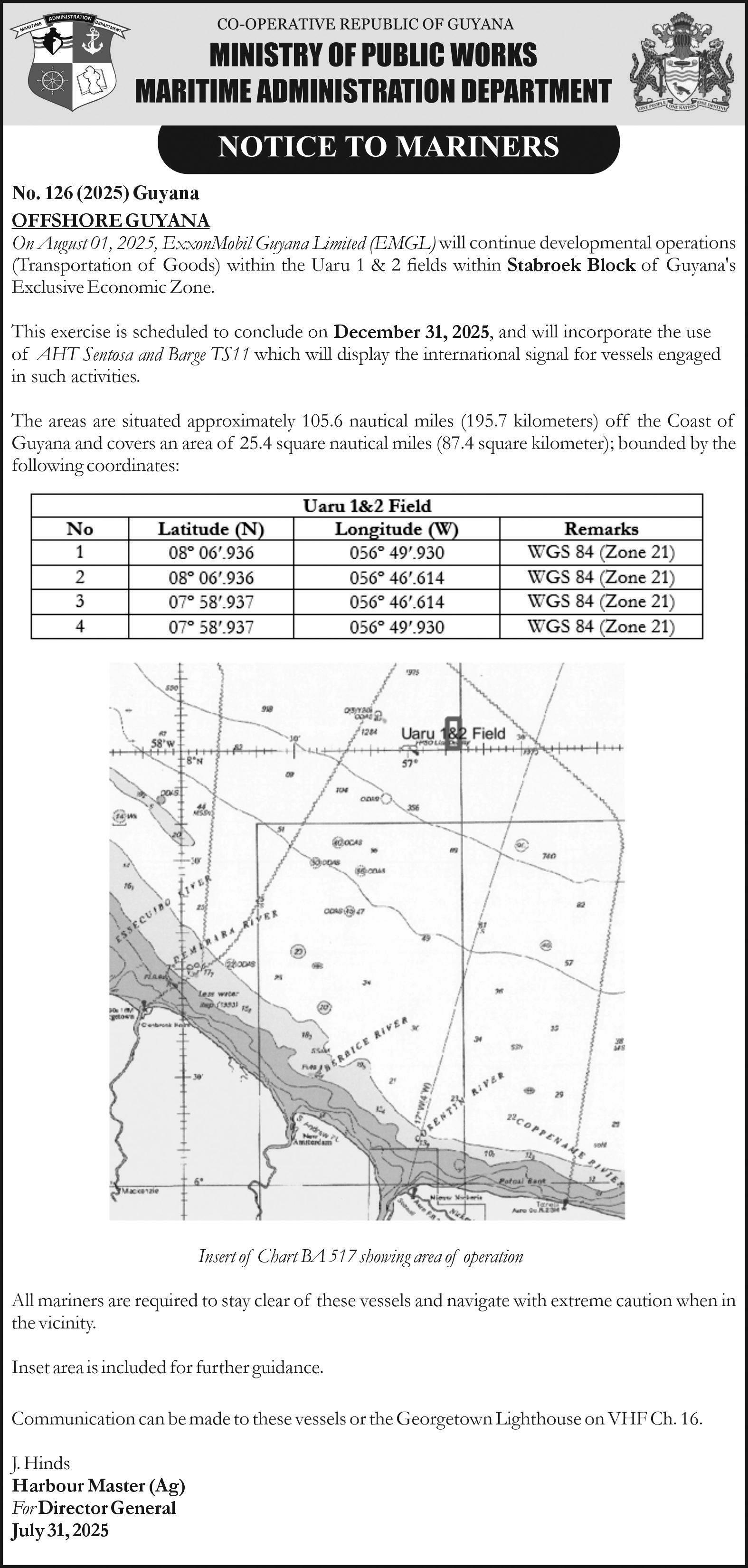
By Feona Morrison
THE government’s planned US$25 million investment in a modern port facility at Parika, East Bank Essequibo (EBE), is being welcomed as a game-changing move with the potential to dramatically reshape regional food trade and agricultural development.
Komal Singh, Chairman of GAICO Construction and former head of the Private Sector Commission (PSC), said the port is well positioned to support the Caribbean Community’s (CARICOM) food security agenda.
Appearing on the Starting Point podcast this week, Singh described the initiative as both strategic and transformational.
“The location of Parika is very strategic,” he said, adding: “When you look at the region, and the plan to
reduce our food-import bill by 25 per cent by 2025, this has not been achieved due to different issues beyond the region’s control. But, come 2026, this is going to be an achievable target.”
The port will serve as a critical hub in a wider logistics network, enabling Guyana—and by extension, the Caribbean—to shift from food importing to food exporting. Singh highlighted the importance of scaling up agricultural production to take advantage of these new opportunities.
“If we are going to reduce our food-import bill, it means we need to start finding ourselves in an export position, because we are going to be moving to largescale farming,” he said.
Singh also noted that Parika’s proximity to the farming belt of Essequibo and its relative closeness to key Caribbean markets gives it a unique logistical
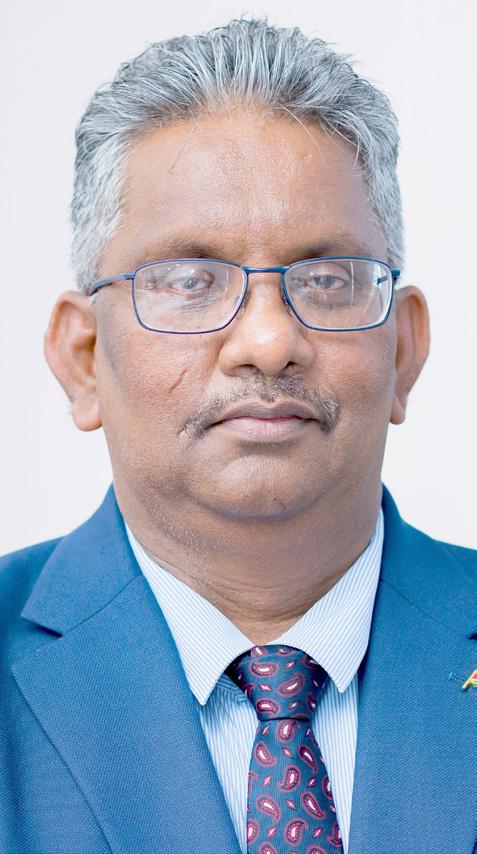
advantage.
“The location of Parika and all the farming being done in the Essequibo region, it is close to the Caribbean. It is a shorter distance from Georgetown, and is going to bring huge benefits to farmers,” Singh stated. He further highlighted that the new port is intended to be more than just a dock-
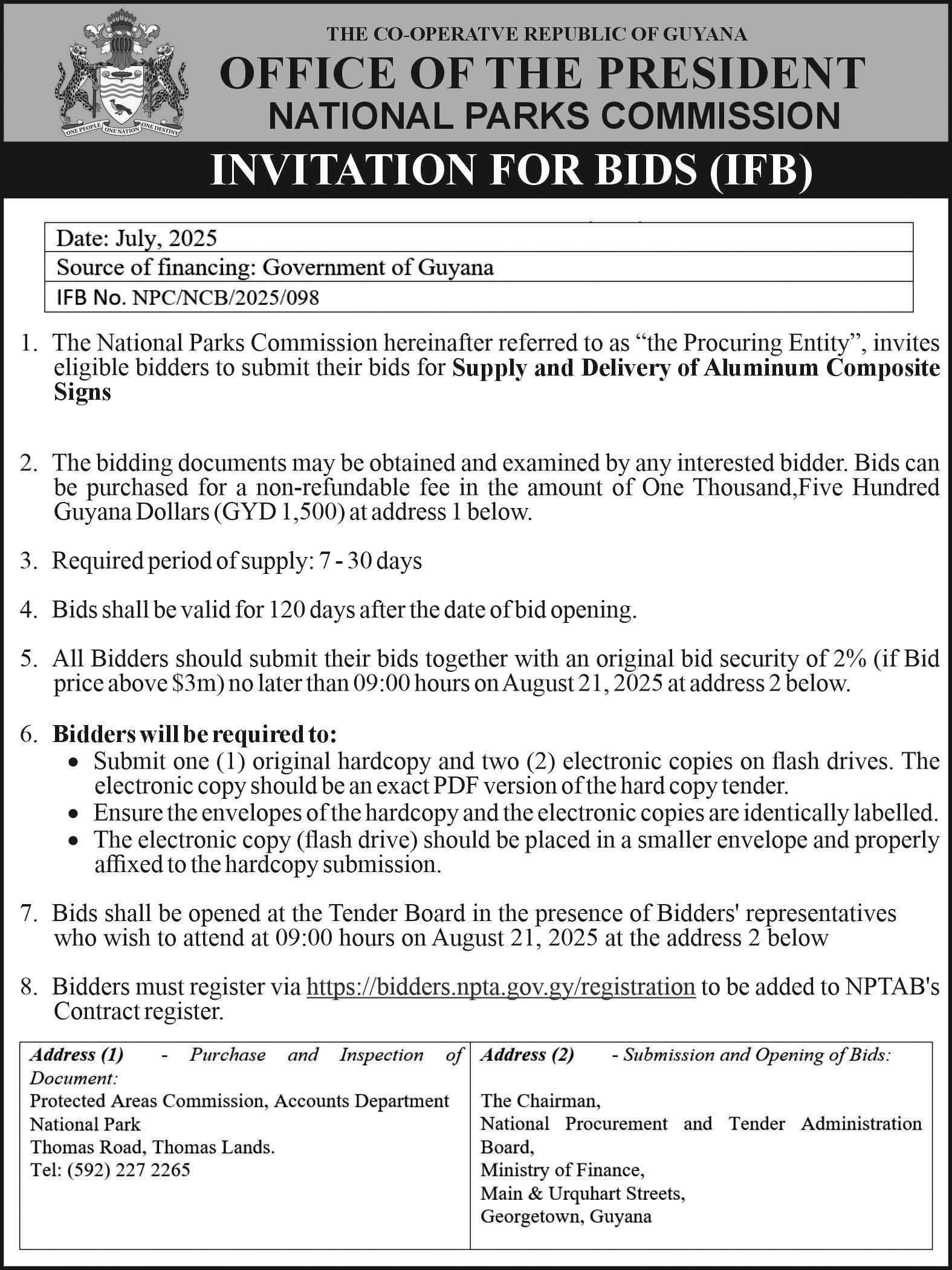

ing area.
“It is not just going to be a port facility; it is going to be a whole ecosystem built on there with cold storage facility, et cetera, to move our stuff very easily,” he said.
He stressed the need to develop supporting infrastructure in tandem with the port, noting: “These facilities need to be built out ahead of the completion of the port facility. You will also need large areas to offload goods and passengers.”
Calling the development a national and regional mile-
stone, Singh said: “That project is going to be transformational for Guyana and the Caribbean.”
The Ministry of Public Works recently held a multi-stakeholder consultation in Parika, where officials detailed the scope of Phase One of the project.
The works include land reclamation, sea defences on both sides of the existing stelling, and the construction of a new concrete stelling.
Three local contractors— GAICO Construction, Toolsie Persaud, and A&S Gen-
eral Contractors—have been tapped to execute the initial phase.
This includes foundation work, superstructure development, and river defence construction.
Once completed, the port will be equipped with advanced cold storage, packaging, and agro-processing facilities designed to extend the shelf life of produce, bolstering regional exports, enhancing food security, and accommodating potential cruise ship docking.
THE United Nations Development Programme (UNDP) reaffirmed at the Global Biodiversity Alliance Summit, its commitment to advance efforts in coordination with the United Nations country teams and development partners, to continue supporting national biodiversity strategies and objectives, linking nature, climate and development as part of the same, and translating high-level commitments as the one, included in the declaration, into tangible results.
The summit, hosted in one of the world’s most forest-rich nations, Guyana, brought together global leaders, development partners and civil society to accelerate action on the Kunming-Montreal Global Biodiversity Framework.
Representing the UN Secretary-General, Michelle Muschett, UN Assistant Secretary-General and UNDP Regional Director for Latin America and the Caribbean, delivered remarks during the
first plenary session of the summit.
During her remarks, she underscored the importance of biodiversity as a foundation for peace, prosperity, and planetary health.
“Latin America and the Caribbean hold immense potential to lead the global shift toward a nature-positive future—not just because of our biodiversity, but [also] because of our commitment to reimagining development.
“Our 2025 Regional Human Development Report is a call to transform the intense pressures on our societies into a force for renewal—one where biodiversity conservation and multilateral co-operation become the foundation of a resilient, inclusive future. Let this summit be the inflection point where urgency meets unity, and where we turn ambition into action for people and planet.”
The UNDP’s participation at the Summit spotlighted its Nature Pledge, a US$3.9 billion portfolio supporting 145 countries to
align biodiversity strategies with climate goals and sustainable development.
Through initiatives such as BIOFIN, the UNDP is helping countries unlock and align finance for biodiversity, ensuring that nature-based solutions are embedded in national development planning.
In his remarks, Andrew Seidl, Senior Technical Advisor for the Biodiversity Finance Initiative (BIOFIN), UNDP Nature Hub – emphasised the importance of us viewing biodiversity beyond the concept of animals and plants: “Above all, we have learned to ‘think globally, but act locally,’ and that the effects of biodiversity loss, climate change and land degradation are felt most strongly by the most vulnerable in society.”
Further explaining that financial innovation and partnerships are of the utmost importance when talking about biodiversity
ee page 15
IN a bold step towards inclusive national development, the Government of Guyana, through the Ministry of Human Services and Social Security, has officially launched a new Youth-Friendly Space and Sewing Hub at the West Berbice Centre in Bush Lot, West Coast Berbice, aimed at empowering citizens from childhood to adulthood.
During the launch, Minister of Human Services and Social Security Dr. Vindhya Persaud reaffirmed the government’s unwavering commitment to personal development for all Guyanese, regardless of age, gender, or background.
“People are at the heart of development,” she declared. “Our country can only truly prosper when its people are uplifted.” The Youth-Friendly Space, catering to children as young as nine, offers a safe and supportive environment where they can access educational support, counseling, and recreation.
“We are placing trained personnel here who will assist with homework, provide emotional and mental-health support, and engage youths in meaningful activities,” Dr. Persaud noted.
The facility will also include sports equipment, television, games, and a soonto-be-established library, forming part of a comprehensive initiative to help young people navigate modern challenges such as bullying, body-shaming, and emotional or verbal abuse.
Upstairs, the Sewing Hub is geared towards women's empowerment by equipping them with practical skills that can lead to financial independence.
The programme also contributes to the government’s school uniform initiative, and is inclusive of Persons Living with Disabilities (PLwDs), who will also be trained at the facility.
Importantly, while the Sewing Hub primarily targets women, Dr. Persaud emphasised that men are equally welcome to enroll and benefit from the programme.
Looking ahead, the Minister announced plans to roll out additional activities for senior citizens, including digital literacy, exercise, and knitting sessions, ensuring that the elderly are not left behind in the nation’s developmental drive.
“This is what people-centered development truly looks like,” Dr. Persaud said.

“From the cradle to the later years of life, the Government of Guyana is investing in every citizen’s growth and well-being.”
The launch marks another stride in the Ministry’s ongoing mission to strengthen communities and foster lifelong learning and empowerment for all.
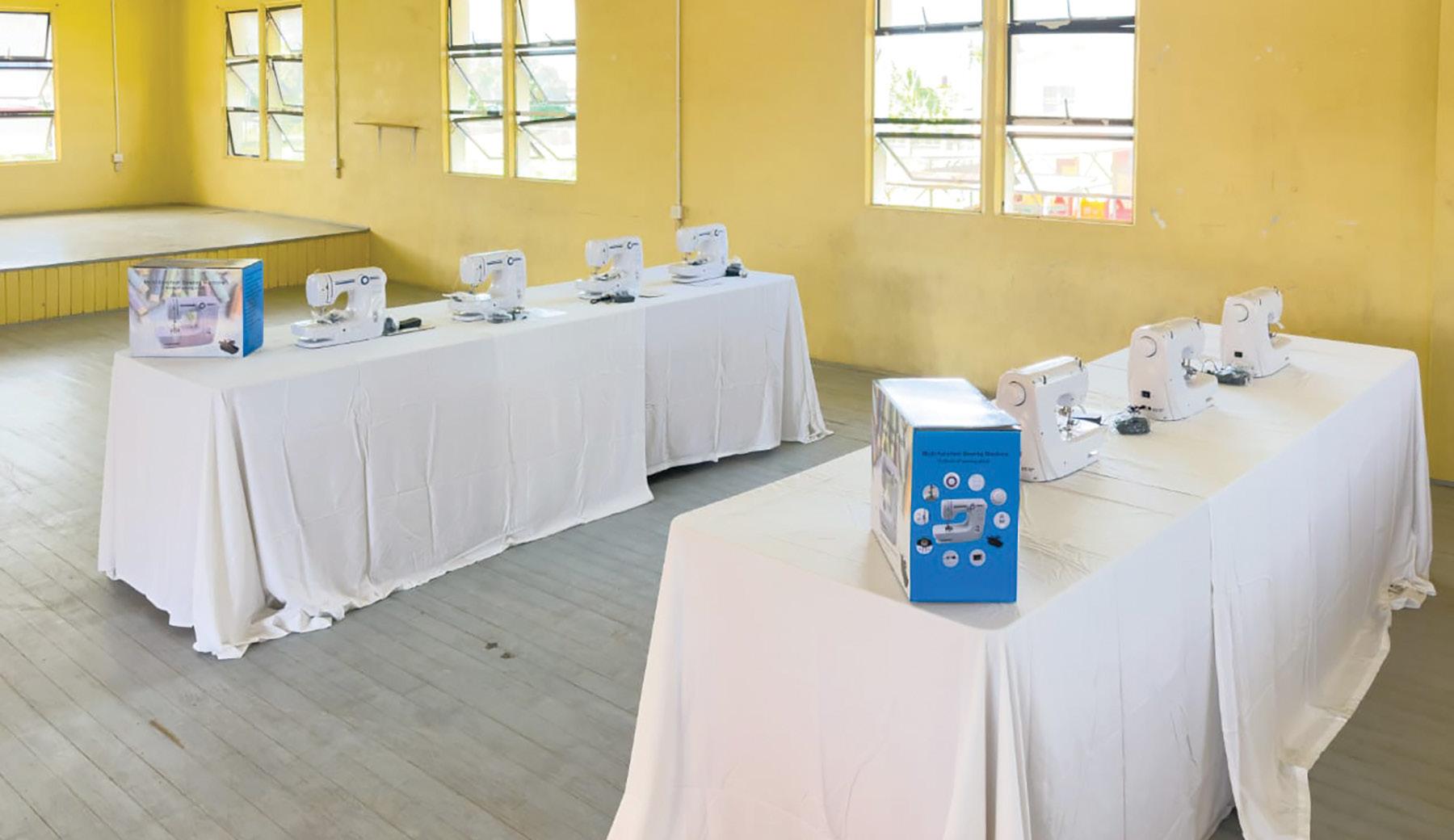


THE fire which gutted the headquarters of the Guyana Trades Union Congress (GTUC) and its education arm, the Critchlow Labour College (CLC) last Thursday, was maliciously set, Fire Chief Gregory Wickham has confirmed.
Speaking via telephone on Monday, Wickham disclosed that investigators concluded this after wrap-
ping up their probe based on evidence gathered at the scene. The findings have been handed over to the police as investigations continue.
The building is located at Woolford Avenue, Georgetown. It is owned by the GTUC, and at the time housed the CLU, University of Excellence, Management and Business, and the An-
gela Apple-White-Hercules canteen.
Wickham had previously told this publication that the Guyana Fire Service (GFS) received the alert about the blaze at around 23:45hrs on Thursday. He said firefighters, along with three fire tenders, were dispatched to the scene within five minutes.
Upon arrival, he said,
one of the buildings was already completely engulfed in flames, with several pockets of fire observed throughout the structure.
Given the intensity of the blaze, an additional fire tender had to be deployed to help bring the situation under control.
Meanwhile, eyewitnesses at the scene alleged that the fire was maliciously set by persons known and unknown for insurance.
However, the GTUC in a statement had expressed deep sorrow over the destruction of its facilities, which include the long-standing Critchlow Labour College—an institution that has educated generations of Guyanese across all regions and ethnicities over its 50-year history.
“The education arm of the GTUC has served hundreds of thousands of Guyanese, from all walks of life, all ethnic groups, from all

parts of Guyana,” the statement read, adding: “A great percentage of these benefitted from a ‘Critchlow’ education that enabled them to enter the Cyril Potter College of Education, the University of Guyana, and other tertiary institutions.”
The union noted that this was not the first fire to destroy its property, recalling that the initial blaze occurred on March 22, 2025. The GFS determined that the fire was caused by outdated electrical panels overheating.
REPUBLIC Financial Holdings Limited (RFHL) has reported a profit after-tax and non-controlling interest of US$225 million for the nine-month period ended June 30, 2025, marking a solid 1.7 per cent compound annual growth rate in profit since 2020.
The Group’s strong performance comes amid what Chairman Vincent A. Pereira described as “a challenging global operating environment”. According to a statement, he credited the group’s
“Our asset base remains robust, reinforced by strong capital positions and healthy liquidity buffers, which continue to support our longterm strategy,” he added.
As part of its regional expansion strategy, RFHL also completed its acquisition of the remaining shareholding in Cayman National Corporation in the Cayman Islands.
The deal closed on July 29, 2025. Reflecting confidence in the Group’s outlook, the Board of Directors declared a third interim div-

“resilient, strong diversified business model and prudent risk management” for the consistent growth.
Pereira said that RFHL’s core banking operations showed continued momentum, buoyed by growth in net interest income and improved customer engagement across key markets.
The Group also made strategic investments in digital and data platforms and customer relationship enhancement across its subsidiaries.
“Our performance is testament to the commitment of our teams across all our subsidiaries,” Pereira said in his statement.
idend of US$0.15 per share, payable on August 29, 2025 to shareholders on record as of August 15.
“We remain confident in our ability to adapt and deliver long-term value,” Pereira said, adding that the Group would maintain its focus on “operational efficiency, employee management, risk discipline, and delivering superior customer experiences”, as it aims to become a more agile and future-ready organisation.
Pereira also expressed appreciation to the Group’s employees, customers, shareholders, and regulators “for their continued support”.
‘You will
--VP Jagdeo affirms backlog of housing applications will be addressed; everyone will benefit
EFFORTS to clear the housing backlog is being accelerated, and Vice-President, Dr Bharrat Jagdeo has assured applicants awaiting allocations that they will receive their houselots.
The Vice President made these remarks during a radio programme on Monday, when he discussed the government’s aggressive housing drive, from which thousands of Guyanese have benefitted.
The People’s Progressive Party/Civic (PPP/C) government officially surpassed its ambitious target of 50,000 house lots within five years, bringing new hope and tangible change to citizens across the country.
The Vice President stated that the government is dealing with the housing backlog that the previous APNU+AFC government left and currently, they are addressing applications up to 2019.
He also noted that the wait is a bit longer in Region Four because of the demand.
To meet housing demand, the govern-
ment is opening new residential areas, including 20,000 house lots on the East Coast of Demerara.
He said: “So the wait is a little bit longer in this region [Four], but they’re going to get it.”
He added: “So I guess all the people who've applied before, by next year, they will get their plots of land in the other regions of the country. But in Region Four, where everyone wants to come, we have a huge backlog. But people will get it.”
Dr Jagdeo underscored that the PPP/C has remained the only party that fulfils its promises.
The government’s housing strategy has proven to be more than an infrastructural project—it is a national movement focused on stability, growth, and equity.
For many, these lots represent more than parcels of land—they symbolise hope, independence, and a new beginning.

IN a bid to eliminate Lymphatic Filariasis (LF), another round of mass drug administration is set to take place, targeting Regions Three and Four
This was disclosed on Monday during the launch of the Lymphatic Filariasis mass drug administration training being done in collaboration with the Pan American Health Organisation/World Health Organisation (PAHO/WHO).
Lymphatic Filariasis, commonly known as elephantiasis, is a neglected tropical disease caused by parasitic worms transmitted through mosquito bites.
According to Minister of
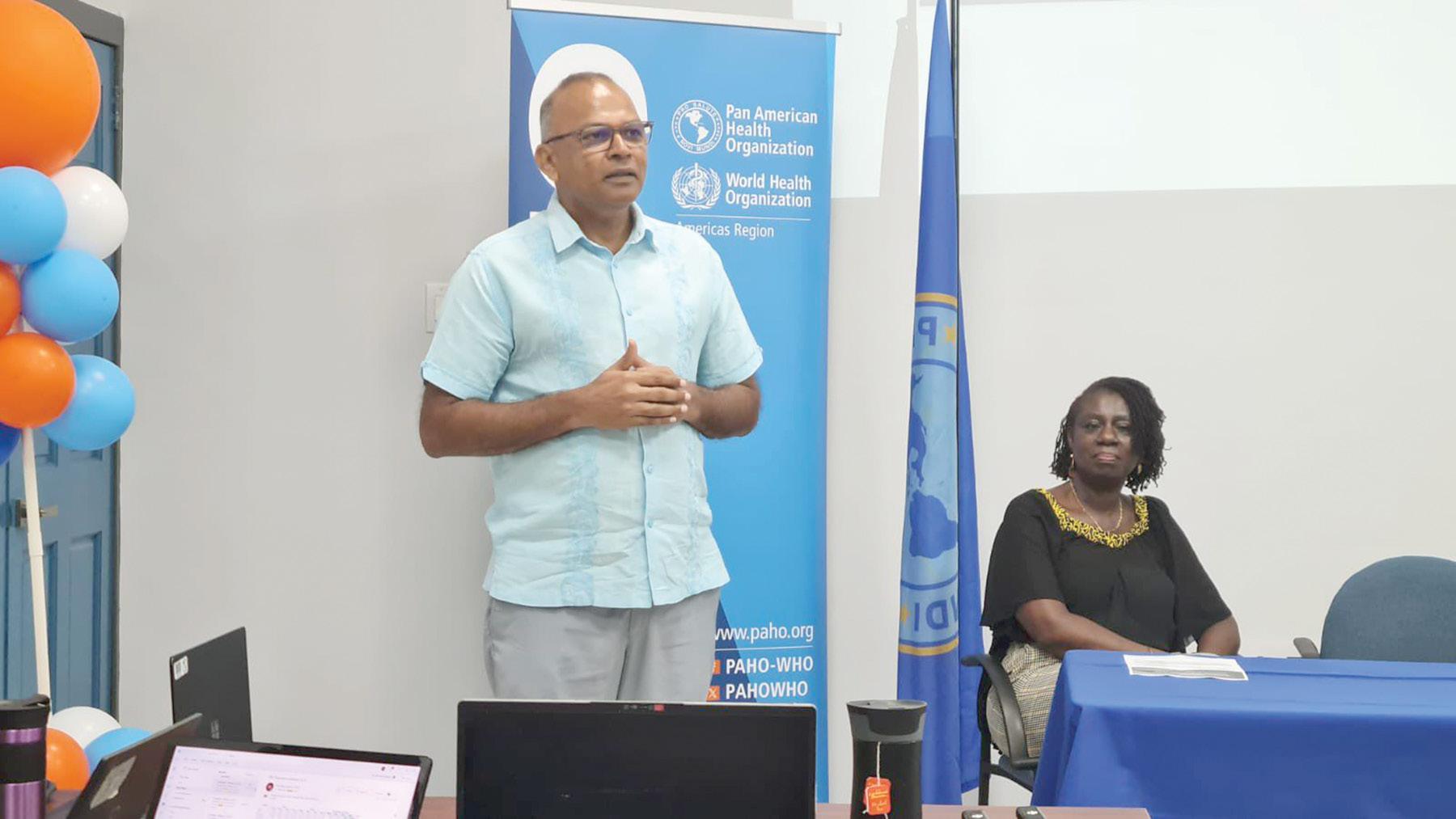
Health Minister Dr Frank Anthony
Health Dr Frank Anthony, this is a problem that has persisted in Guyana for quite
some time; however, the country is close to eliminating the disease, with it being
eliminated from eight of Guyana’s 10 administrative regions.
To this end, he noted that more work needs to be done in specific communities in Regions Three and Four.
“That is why we are going back this year to ensure that we cover these areas thoroughly, and I think if we do that, we are going to be able to then say sometime next year or the year after that, we have eliminated [LF] from all regions in Guyana,” Dr Anthony said.
Against this backdrop, he told those who would be trained that when they embark on the administration, they would go out and ensure that they are taking the right message to persons across the country.
“We have to work with them, and we have to give people information. They might have questions, they might have doubts, we have to give people the information so that they feel confident that they can take these tablets,” Dr Anthony said.
According to PAHO/ WHO, treatment includes three medications, Ivermectin, Diethylcarbamazine and Albendazole, done in a single administration and is the one commonly used in Guyana.
This triple administration reduces much more and for a longer time, the number of microfilariae in the blood.


FOLLOWING the Memorandum of Understanding (MoU) signed earlier this year, the Iwokrama International Centre (IIC) and the British Chamber of Commerce Guyana (BritCham) convened a meeting to discuss collaboration to promote and support the work of the centre and the LCDS 2030.
The centre presented its work programmes to BritCham’s membership and areas of initial collaboration were discussed.
British High Commissioner to Guyana, HC Jane Miller, noted “Iwokrama is a symbol of Guyana’s global leadership on climate and biodiversity. I am pleased to see BritCham stepping up as a key partner in advancing sustainable development through private-sector engagement. This growing partnership signals important momentum for conservation-focused collaboration between the UK and Guyana’s business community.”
Chairman of BritCham, Faizal Khan, noted “This collaboration with Iwokrama marks a significant step
for BritCham as we deepen our support for initiatives that align with sustainable business practices. We are excited to offer our members opportunities to engage directly with Iwokrama’s pioneering work in conservation, science, and community development.
“Our shared vision includes not only strategic events, but also tangible programmes, such as anti-littering campaigns and eco-tourism promotion, that reflect our long-term commitment to environmental leadership and responsible commerce.”
Chief Executive Officer (CEO) of Iwokrama, Dane Gobin, states: “I am very happy with how the collaboration discussions went and I congratulate the membership of BritCham for pursuing socially, environmentally and ecologically best practices as they operate their businesses.
“This partnership aligns with Iwokrama’s mission to balance economic growth with the conservation of Guyana’s unique biodiversity. Inspired by His Majesty
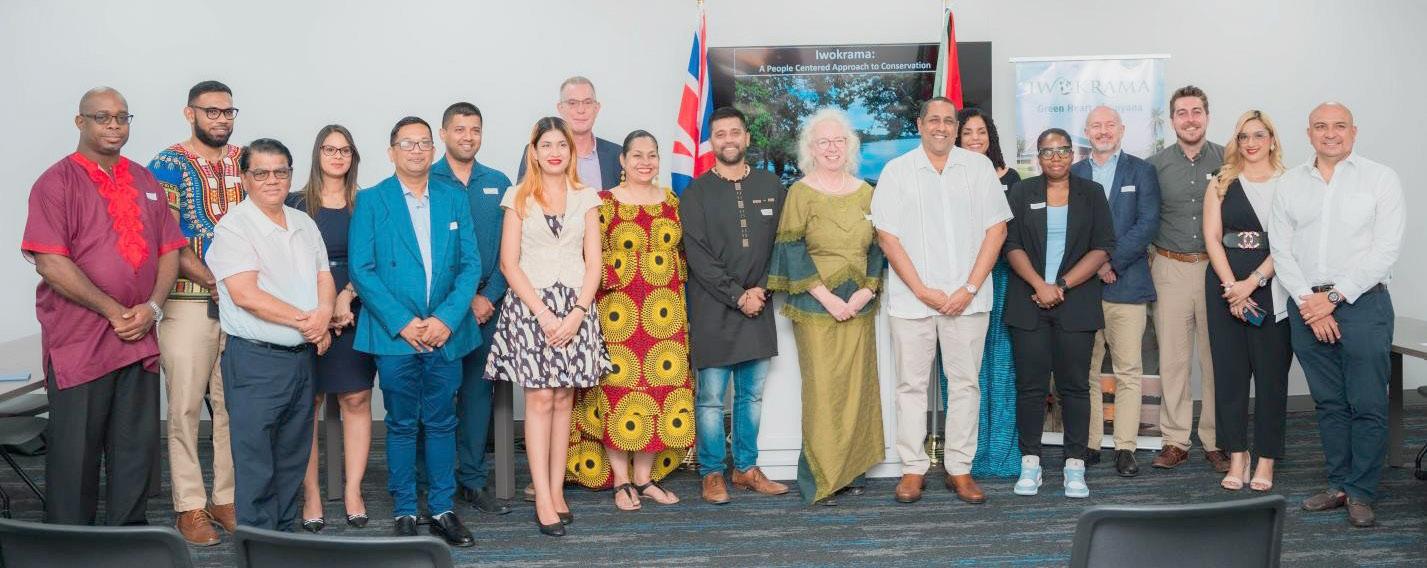
King Charles III, Britain’s Head of State and Patron of Iwokrama, we are dedicated to promoting sustainable forest practices and environmental stewardship across our network.”
In the coming months, BritCham and Iwokrama will roll out these joint initiatives which will include but not be limited to anti-littering campaigns, community livelihood programmes, forest conservation and research.
protection and interventions, “Local ownership and political commitment, inclusive governance, science and data, sustainable finance, local capacity, innovation and communication are key to unlock these solutions for these local and global challenges.”
Ahead of the summit, on the United for Biodiversity’ podcast, Katy Thompson, UNDP Resident Representative for Guyana and Suriname, reflected on Guyana’s leadership and the role of development partners.
She highlighted UNDP’s support to 140 countries in implementing the Kunming-Montreal Global Biodiversity Framework and noted Guyana’s integration of biodiversity protection into national development through its Low Carbon Development Strategy.
By balancing environmental, economic, and social priorities, and centering inclusion, Guyana offers a compelling model for translating global biodiversity
goals into local action, setting a high bar for other biodiverse nations.
UNDP’s integrated programme in Guyana is advancing the country’s Low Carbon Development Strategy (LCDS), disaster risk management and energy transition through a multifaceted approach grounded in inclusion, sustainability, and innovation.
Under the LCDS, UNDP supports biodiversity conservation and protection, while also aligning Guyana’s National Biodiversity Strategy and Action Plan (NBSAP) with the Global Biodiversity Framework.
In disaster risk management, the UNDP works to strengthen national-recovery mechanisms, building on the efforts of other partners, to ensure inclusive and gender-responsive recovery from climate impacts, working closely with national institutions such as the Civil Defence Commission and the Ministry of Local Government.
From page 10
On energy transition, initiatives such as the Just Energy Transition project are building solar-powered EV charging stations and the mainstreaming low emissions project, installing solar panels at water-treatment facilities, with a strong focus on youth and women’s participation.
These efforts are reinforced by UNDP’s role as a trusted integrator, mobilising resources, fostering partnerships, and ensuring that climate resilience, biodiversity, and inclusive development are mutually reinforcing pillars of national progress.
These efforts demonstrate how biodiversity, climate resilience, and inclusive development are mutually reinforcing pillars of UNDP’s work.
As the summit concluded, UNDP reiterated its commitment to working hand in hand with governments, communities, and partners to deliver results for people and planet. (UNDP)
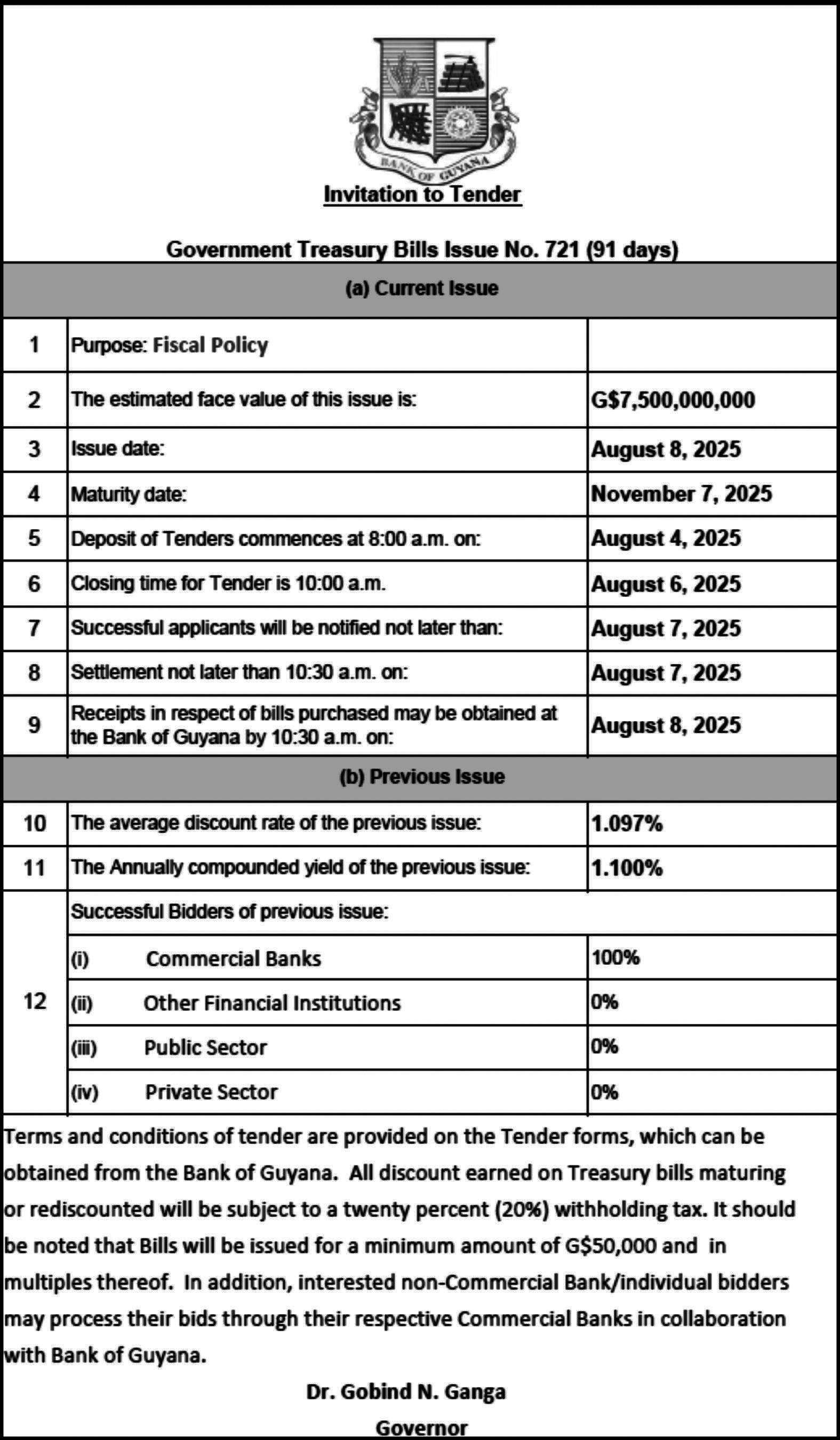
WITH road deaths surpassing the 170 in 2024, Guyana’s Traffic Department is intensifying its battle against reckless driving, seeking to shift deep-rooted cultural habits and restore public confidence in law enforcement.
According to Assistant Commissioner and Traffic Chief, Mahendra Singh, a combination of education, enforcement, technology, and transparency is driving the country’s most aggressive road safety effort in years.
running red lights, neglecting seatbelts, and driving under the influence.
More than 60 percent of fatal accidents in Guyana are linked to speeding and dangerous driving, Singh confirmed. These deadly behaviours, he noted, are rooted in a weak road culture, peer pressure—particularly among younger drivers— and a longstanding tolerance for rule-breaking, including
“Too many drivers still treat traffic laws as optional,” Singh said. “We’re working to change that mindset from the ground up.”
To that end, the Traffic Department has rolled out a series of nationwide public awareness campaigns. These include road safety education in schools, work-

places, hospitals, markets, and faith centres, as well as televised and radio public service announcements and scrolling messages on ⁶digital billboards. Defensive driving seminars are also being conducted for both private and government-employed drivers.
Singh stressed that these efforts are complemented by a stronger police presence in high-risk areas and accident “blackspots,” with enforcement guided by crash data that identifies trends by region, vehicle type, and repeat offenders.
The deployment of surveillance technology and automated ticketing has also begun to yield results.
Thousands of violations—including speeding, red-light breaches, and other infractions—are now automatically captured by cameras under the Smart Road and Intelligent Surveillance (SRIS) system and Smart City platform. The use of these systems not only increases accountability but also minimises the need for officers to stop vehicles on the road, significantly reducing opportunities for bribery.
“Most enforcement is now based on digital evidence, not officer discretion,” Singh emphasised. “Everyone is held to the same standard—same rules, same system, same outcome.”
Public support for speed cameras and e-ticketing has grown steadily, Singh added, noting that future expansion will target more roads, new categories of offences (like driving while using a mobile phone), and wider geographic coverage beyond Georgetown.
In response to growing public concern over heavy-duty trucks, minibuses, and electric bikes, the Traffic Department has implemented stricter regulations across the board.
Heavy trucks and lor -
ries—often flagged for overloading, unsecured cargo, and nighttime speeding—are now under tighter scrutiny, especially on major supply chain routes involving sand, stone, and logs. Police are coordinating with the Ministry of Public Works to enforce axle load limits, conduct roadworthiness checks, and maintain weigh stations. New police outposts have been established along key corridors for 24/7 monitoring.
Minibuses, known for erratic driving, speeding, and blasting loud music, are subject to greater oversight through stricter control of fitness certificates, service licences, and joint patrols with traffic stations. Singh said these sustained measures led to a reduction in serious crashes involving minibuses in 2024.
Electric bikes, increasingly common in urban zones and private compounds, are now being regulated through a phased licensing regime aimed at promoting accountability and safety. Public education campaigns are also underway to support this initiative.
Poor road conditions— especially in remote areas— remain a major contributing factor to traffic accidents, Singh acknowledged. He said police are now working more closely with the Ministry of Public Works to share crash data, conduct joint safety audits, and initiate targeted improvements.
“We’ve seen real impact from things like new signage, reflective road paint, speed bumps, and better lighting,” Singh noted.
In areas where resurfacing is delayed, police are deploying temporary warning signs and increasing community outreach to prevent accidents. While resource limitations continue to affect the pace of road upgrades, Singh said coordination between agencies has significantly improved.
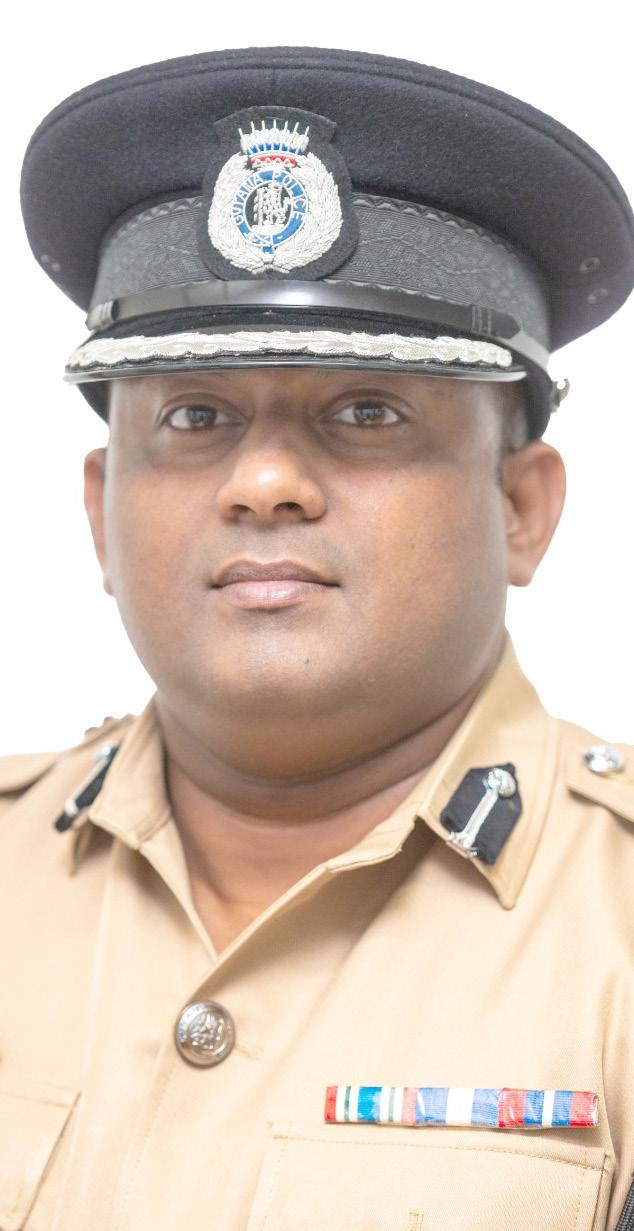
Commissioner and Traffic Chief, Mahendra Singh
One of the most persistent complaints from the public has been the perceived inequality in how traffic laws are enforced— especially in Regions Four, Six, and 10.
To combat this perception, Singh pointed to a series of integrity-driven reforms: SRIS cameras and e-ticketing systems eliminate human bias by relying entirely on digital evidence; Body-worn cameras are now standard for all operational traffic officers; and the department has introduced internal monitoring systems to track enforcement patterns and identify irregularities.
“Officers are being held accountable,” Singh said. “We’ve already launched investigations into several bribery complaints, and disciplinary action is being taken where appropriate.” He underscored a clear message to both officers and the public: “No exceptions — the law applies to everyone equally.”
While Singh acknowledged that Guyana’s traffic culture will not change overnight, he remains confident that the current combination of education, enforcement, technology, and public accountability will yield lasting results.
“Our goal isn’t just to catch violators — it’s to build a safer, more respectful road culture,” he said.
GUYANA has recorded a substantial increase in passenger traffic over the past five years, a feat driven by targeted investments and strategic initiatives of the PPP/C government.
According to a recent report from the Ministry of Public Works, international passenger movements at the Cheddi Jagan International Airport (CJIA) and the Eugene F Correia International Airport (EFCIA) rose from 205,297 in 2020 to 938,715 in 2024.
This represents a staggering 375 per cent increase in just four years, a recovery and expansion set to exceed one million passengers in 2025, far exceeding pre-pandemic levels.
This growth is fuelled by the government’s successful efforts to attract new international carriers and expand global connections.
Beginning in 2020, to date, Guyana has signed air

services agreements with Suriname, Colombia, the Netherlands, India, China, Saudi Arabia, the Dominican Republic, Latvia, South Korea, and the Bahamas.
Additionally, Memoranda of Understanding for technical co-operation were signed with Rwanda and Brazil.
These agreements create a legal basis for better connectivity and enhance aviation relationships.
Over the last five years, the following airlines have launched, or are set to launch operations in Guyana:
JetBlue (December 2020)
Intercaribbean (December 2021)
Fly Allways (July 2022)
British Airways (March 2023)
Sky High Aviation Services Dominicana S.A (February 2024)
United Airlines (April 2024)
LIAT 2020 (November 2024)
Avianca Airlines (December 2024)
KLM Royal Dutch Airlines (June 2025)
Air Transat (Coming soon in December 2025)
Air Navigation Services have also seen increased demand.
In 2024, 86,319 aircraft were guided within the Georgetown Flight Information Region (FIR).
This is up from 68,937 aircraft in 2021, representing a 25 per cent increase in aircraft movement for the period 2021 to 2024.
This upward trend signals a steady return to preCOVID-19 operational levels. Meanwhile, several new aircraft have been added to Guyana’s domestic fleet between 2020 and 2025.
Operators such as Roraima Airways; Trans Guyana Airways; Xen Aviation; Jags Aviation; Air Services Limited; AG Air; the Guyana Defence Force; the Sheriff General Hospital; and Peter Lewis have all imported aircraft, many of which were purchased brand new, directly from the factory.
New aircraft types introduced include the Bell 505, Tecnam P2012, and Hindustan 228, marking a continued upgrade in Guyana’s aviation capacity and technological advancement.
The developments highlight the government’s plan for the aviation sector, making Guyana a regional centre for air travel and commerce. (DPI)



a triple.
Lanferman came to the fore with goals in the 35th, 40th and two more in firsthalf injury time.
(From page 27)
Mainstay had a consolation goal from Elvis Marvel in the dying minutes of the contest.
In another blockbuster
His teammates Stephon Jupiter, Jomal Robinson and Jamal Petty also recorded doubles to complete the rout.
match-up Slingerz Football Club had to settle for a draw against Western Tigers also on Sunday.
Western Tigers’ William Europe was the first to the back of the net in the 14th minute until a 31st minute strike from Darron Niles equalised the scores. The remainder of the clash saw no more addition to the score, as it ended in a 1-1 stalemate.
single to long on off Romario Shepherd.
Ayub then reached his milestone by clobbering Shepherd for a six and four off consecutive deliveries, followed by a single in the 13th over as Pakistan eased past the 100-run mark.
Shamar Joseph finally got the breakthrough for the West Indies when he had Farhan caught by Shai Hope at long off after he faced 53 balls and struck five sixes and three fours.
Ayub then added 20 runs in just nine balls with Hasan Nawaz, before the former was dismissed by Jason Holder to leave Pakistan 158 for two in the 18th over.
Pakistan finished the innings with a flourish by blasting 30 runs from the last two overs, with both Khushdil Sah, who finished unbeaten on 11 not out and Faheem
Ashraf, who made 10 not out, hitting towering sixes.
West Indies got off to a blazing start in their run chase, with Jewel Andrew hitting Hasan Ali for three boundaries in the first over, while Athanaze thumped Mohammad Nawaz – who was adjudged Player-of-theSeries – for a six and two fours in the ensuing over to see them race to 33 without loss after two overs.
But they scored just nine runs combined from the third and fourth overs, and it came as no surprise when fast bowler Haris Rauf had Andrew caught at long on for 24 with 44 runs on the board.
Skipper Shai Hope and Andrew then added 30 runs in four overs, until Hope hit Mohammad Nawaz straight into the hands of deep cover to be out for seven.
Athanaze eventually
bering their number 20 - a number that has been retired by the club this summer.
Both sets of players, coaches and fans applauded as both games were stopped in the 20th minute.

(From page 27)
reached his maiden T20I half century off 31 balls and together with Rutherford put West Indies in a strong position at 110 for two in the 12th over.
And even after Athanaze’s dismissal, caught at short third man off the bowling of Ayub for 60, inclusive of eight fours and one six, West Indies still held the upper hand with Rutherford and Roston Chase combining in a 39-run partnership that required four overs and took them up to 149 for three in the 17th over.
With West Indies requiring 41 runs from 18 balls and
in dire need of boundaries, Chase retired out to make way for the bigger hitters.
However, the Windies never found their momentum after that, with Jason Holder’s dismissal for a two-ball duck in the 18th over by Sufiyan Muqueem that only went for eight runs, proving to be the nail in the coffin.
Rutherford tried his best and reached his 50 off 32 balls by hitting Rauf over cow corner for six in the penultimate over, but with 25 runs required off the final over, Pakistan held their nerves to cruise to a comfortable win in the end.
(Tuesday, August 5, 2025)
COMPLIMENTS OF CUMMINGS ELECTRICAL COMPANY LTD 83 Garnett Street, Campbellville, Georgetown (Tel: 225-6158)
(From page 26)
Jota scored 65 goals in 182 appearances for the Reds, helping them win the Premier League, FA Cup and League Cup, following his arrival from Wolves in 2020.
"I know that you will want to pay your tributes before, during and after the games, and I know that we will hear his song ringing out throughout the evening," said Reds boss Arne Slot in his match programme notes.
"It has been a tough time for everyone connected with the club, but especially for Diogo's family, his wife, his children and friends.
"We cannot imagine the pain that they have been going through, and the club will continue to give them all the support they can going forward. We will always carry him with us in our hearts, in our thoughts, wherever we go.
"Diogo's passing has had a big impact on us all, but what has been so important has been the love and care shown from the football world, and in particular of course the Liverpool FC community."
The Reds play Crystal Palace in the Community Shield at Wembley on Sunday, 10 August, and open the Premier League season at Anfield against Bournemouth on Friday, 15 August. (BBC Sport)
Answers to yesterday’s quiz: (1) Shai Hope-6 catches (2) Josh Inglis-3 (2 catches/1 stumping)
Today’s Quiz:
(1) How many centuries were scored in the recent WI/AUST T20 series?
(2) How many other scores of over 50 were compiled?
Answers in tomorrow’s issue

THIS series between England and India has definitely been the best that I have been involved in since the Ashes in 2005.
Winning in Australia in 2010-11 was also special, but this has had all the ingredients that makes Test match cricket so special - the intensity, the combative nature at times, the immense skill.
It has had everything; it has been every bit as competitive and compelling as any Ashes series.
Of course, England supporters would have loved Gus Atkinson to have scored those runs, even just six more for a tie, but to get a finish like that - regardless of who wins - is absolutely great for Test cricket.
Ultimately it was India who won the fifth Test by six
runs to secure a 2-2 draw, a result they deserved.
I've enjoyed the competitive nature throughout; it is what Test cricket is all about.
You don't see it in T20 or franchise cricket. It shows how much people and the players care about Test cricket and playing for your country, you can tell the difference.
The 7,187 runs scored is the most in a five-Test series, and it is just the second time in the past 20 years that every game in a series of that length has gone to a final day.
If any administrator in the world game looks at this series and is considering four-day Tests as the way to go, they shouldn't be an administrator in cricket. That's all that needs to be said.

ments in this match, particularly with 73 runs needed with seven wickets in hand, England should be winning from there.
There will be comments about Harry Brook's dismissal and I'll be one who says, really, was that necessary? With the game just within your grasp, the really hard-nosed professional attitude is that you win the game.
Joe Root and Brook had just snatched the game away from them with such an incredible 195-run partnership.
home!
At the start of the series my worry was that if it didn't go well, all of England's carefully laid plans for Australia could be in a mess and you wouldn't know what they would do, going forward. But it has not been the case at all. We have been choosing our starting XIs for the first Test in Perth and it is pretty much the same as it would be if we had sat down in May and answered the same question.
That is such a positive place to be - it sends a real message to Australia.
We had the fourth day on a Sunday at The Oval and it was absolutely packed, and a sellout on day five which is fabulous.
And this morning, to see Chris Woakes hobbling down those steps at number 11, it was just pure drama.
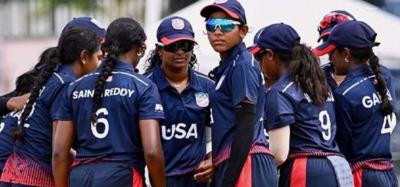
PORT OF SPAIN, Trinidad, (CMC) – USA Under-19 Women ended a successful tour of the Caribbean with a 15-run victory over West Indies Under-19 Women in the sixth and final Youth T20I here on Sunday.
Playing at the Sir Frank Worrell Memorial Ground, USA were bowled out for a meagre 88 in 19.5 overs after being sent in to bat.
However, the visitors’ bowlers then produced a tremendous effort to dismiss the West Indies for just 73 off the last ball of the match. It helped USA rebound from losing the opening match to win the series 3-1
after two of the matches were rained out.
The USA found themselves in trouble early on after Theanny Herbert-Mayers struck twice to see them reduced to 18 for three in the fifth over.
However, Nikhar Doshi, who made 23 and Hashini Karthikeyan, who scored 21, rescued their side in a fourth-wicket partnership of 52.
West Indies fought back at the death though, and once Doshi was dismissed at the end of the 15th over, USA lost their last seven wickets for 18 runs. The home side would, however, have been disap-
pointed with the 25 extras they gifted USA, the top contributor to the score.
Aaliyah Weekes finished with 3-14, Herbert-Mayers 2-18 and Danellie Manns 2-28.
Needing a win to tie the series, West Indies collapsed from a comfortable position of 30 for one in the seventh over to lose four wickets for just eight runs to see them slump to 38 for five.
It was a position they would not recover from, as Taranum Chopra (3-8), Chetna Pagydyala (2-8) and Sainavi Kambalapalli (2-11) bowled USA to victory.
Colin Cowdrey batted with a broken arm in 1963, though he also did not face a ball, but Paul Terry did when he faced West Indies with his arm in a sling in 1984.
It was a relief that Woakes managed to stay at the non-striker's end because I'm not sure how India would have bowled to him.
It's all well and good to say you go there and bounce it in at his shoulder or whatever, but it's not very nice when you are faced with that possibility as a bowler.
If you go back to key mo-
But if you speak to Michael Vaughan and Sir Alastair Cook, people who have scored far many more Test runs than I have, they'll say they're OK with it, so an old-timer shrugs his shoulders and says 'fair enough'.
But Brook was the only one who could have seized the game in the manner that he did because Root just played in his quiet, professional way.
He has since said he regretted the shot that got him out and fair enough to him, it's big of him to say that. You just hope that next time, in Sydney when they're 2-1 up to win the Ashes, he'll see England
India have been outstanding themselves, though. They have not helped themselves in the final match with their selection, but they still won. If you think back to when they were 0-2 in Manchester at the start of their second innings, they have shown enormous resilience. They are a new team and although Shubman Gill is very laid-back outwardly, he has a steely side to him - he reminds me of David Gower. He will learn so much from this experience and they seem to have great spirit.
(Jonathan Agnew)
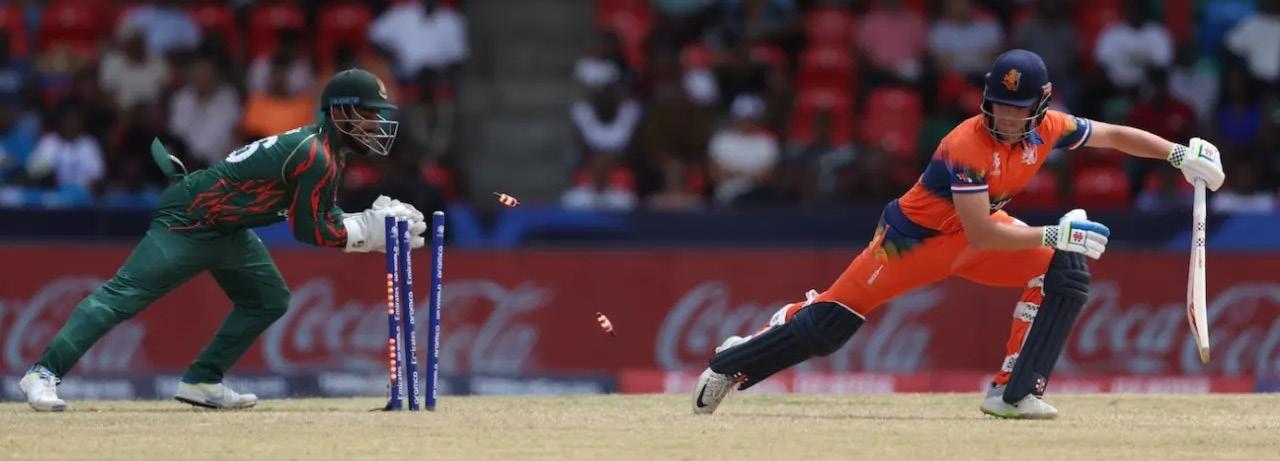
Bangladesh and Netherlands last faced each other at the 2024 T20 World Cup
NETHERLANDS will play their first bilateral series in Bangladesh when they arrive in the country later this month for three T20Is. The series will give Bangladesh some competitive cricket leading up to the Asia Cup, which begins on September 9.
Netherlands will land in Dhaka on August 26 before heading to Sylhet, where they will train for three days before the first T20I on August 30. The second and third
T20Is are also in Sylhet, on September 1 and 3. All three matches will start at 6.00pm local time.
The BCB arranged the Netherlands series after India postponed their tour to Bangladesh, which was to feature three ODIs and three T20Is from August 17 to 31. It had left Bangladesh with a month of no international cricket before the Asia Cup. Initially, the BCB were also in talks with the Nepal board. Netherlands have played in Bangladesh once before, in the 2014 T20 World Cup where they won a memorable game against Ireland to confirm their progress to the main round.
Bangladesh and Netherlands have played only five T20Is against each other, with Bangladesh winning four of them. In 2012, Netherlands had hosted Bangladesh for two T20Is, their only bilateral series against them before the upcoming tour. (ESPN Cricinfo)
INDIA captain Shubman Gill has said his team was "pretty confident" of taking the remaining four wickets on the final morning at The Oval to level the Anderson-Tendulkar trophy.
Late rain on day four dragged the game into the fifth day, leaving England needing 35 runs and India four wickets. Mohammed Siraj picked up three of the four wickets to seal a stunning win for the visitors.
"Yeah, we were pretty confident," Gill said at the post-match presentation. "Even yesterday we knew that they [England] are a little bit under pressure. We just wanted to make sure that they're feeling the pressure throughout. Pressure makes everyone do things that they don't want to, and we just wanted to make sure that they're feeling the pressure throughout the 37 runs that they scored.
"I think the way both the teams played in the entire series, every day coming on day four, day five, and never really knowing which team is going to win… it shows that both the teams came up
with their A game and very happy to get over the line in this one.”
Joe Root had said that the use of a heavy roller would benefit England on the fifth morning, but Siraj and Prasidh Krishna worked in tandem to give no respite to Jamie Smith and the tail.
Though England required only 35 on the final morning, it was still a stiff challenge against his attack, Gill said.
"When bowlers like Siraj and Prasidh are bowling like that then 35 runs is also too much," Gill said at the postmatch press conference. "As a batsman you are under pressure as you feel the ball is doing something and it takes just one ball. And that is what we were reminding them about the same frequently. If the conditions are like this and the momentum is with you then 30-35 runs is enough, then you know it is a matter of one or two balls falling in the right place and the game will get over there and then."
Gill said that India never thought about taking the second new ball, considering the movement both his strike bowlers had been getting
since day four. "Also, we had the wicket-taking option on this wicket," Gill said. "If they had to make the runs, they would need to score boundaries. We knew they were under pressure because in such a position the batting team is under pressure because it is matter of one ball."
Having been left heartbroken after he was the last man dismissed in the Lord's Test last month, Siraj finished the game this time with the ball at The Oval on Monday, when his pinpoint yorker uprooted Gus Atkinson's off stump. Siraj put in a big shift, with his 30.1 overs in the fourth innings bringing him five wickets.
"Yes, definitely, he's a captain's dream", Gill said of Siraj. "Coming in five Test matches, every ball, every spell that he bowled gave his all out, and every captain, every team wants a player like him. We are very fortunate to have him in our team.”
While Siraj won the Player of the Match award, Gill was chosen as India's Player of the Series by the opposition coach Brendon
Negating Pakistan’s spinners will be key in ODI series, says Hope
AUDERHILL, Florida, (CMC) – IF the West Indies is to end its 34-year wait for a One Day International bilateral series win over Pakistan, captain Shai Hope believes it hinges on their ability to play spin bowling.
Hope made the assertion following his side’s 13-run loss to Pakistan in the third and final T20I at the Broward County Stadium on Sunday, which saw them lose the three-match series 2-1.
During that series, West Indies was undone by the left-arm spin of Mohammed Nawaz, who took seven wickets and was named Player-of-the-Series.
Nawaz will also feature in the upcoming three-match ODI series, which bowls off on Friday at the Brian Lara Cricket Academy in Trinidad.
Pakistan also boasts of left-arm wrist spinner Su -

fiyan Muqeem, off spinner Saim Ayub and leg spinner Abrar Ahmed in their ODI squad. The West Indies last won an ODI series against Pakistan back in 1991, when they prevailed 2-0 and Hope said assessing the conditions quickly and dealing with the spinners that Pakistan will undoubtedly throw at them would be key if they were to
McCullum for his chart-topping 754 runs in ten innings at an average of 75.40. Gill's series aggregate is the second highest for a captain behind Don Bradman's 810 against England in the 1936-37 Ashes. No other batter has scored more runs in a series between England and India, going past Graham Gooch's 752 runs in 1990.
"Feels very rewarding," Gill said. "I worked pretty hard before the start of the series. There were certain things that I wanted to work on as a batsman, and it was my goal to be able to be the best batter of the series. And to be able to accomplish that goal feels very satisfying and very rewarding.
"I think once you are sorted mentally, you would be in a good space. But you're only sorted mentally when you're feeling technically correct. So, I think they're both kind of correlated. If you feel like you're getting in good positions, you're always mentally more stable."
'We want to be looked as a gun team'
Having started their new World Test Championship (WTC) cycle with a series-levelling win, India are currently third on the table with 28 points in five matches.

would feel [at] the end of the series would really help us in the long run in this WTC cycle," Gill said.
Asked if he would have felt the same had England chased the target, Gill admitted that his "feelings would definitely be slightly different".
emerge victorious.
“The first thing is adaptation. Every single place that we played in the Caribbean or here in the US, conditions are so different.
“So, the first thing we need to do is assess, see what’s the best plans to formulate for that particular surface, the wind conditions, all these things we have to take into account,” Hope said.
“But you know they’re going to bowl a lot of spin at us and the way how we negate those spinners in the middle overs is going to be very crucial to us as batters.
“Same thing with the ball, we have to keep find ways to keep making inroads in the same middle overs. So, start with the power play, try to put them under pressure from early and then just try to keep taking wickets throughout the innings and limit the bleeding in the middle,” he added.
"This series was very important for us because the kind of maturity every player
"I don't think the scorecard of the series could not have really depicted what kind of cricket we played," he said. "But this scorecard of the series that we have right now really shows how both teams played. This win was important for us to be able to get that morale high, especially after the kind of cricket that we have played over the course of two months."
When Gill's India had
landed in the UK in June, there were several questions asked of whether his team had the experience and the personnel to challenge Ben Stokes' men. Two months later, India depart with the series shared. Gill credited head coach Gautam Gambhir for building the confidence of the team. "At the start of the series Gauti bhai [Gambhir] said: 'yes, we are a young team, but we don't want to be looked as a young team. We want to be looked as a gun team'. And the way we played it today showed us that why we are a gun team, and we have gun players like him [Siraj] in our team and that's what makes this team so special."(ESPN Cricinfo)
LIVERPOOL paid tribute to Diogo Jota in their first match at Anfield since the late forward's death. The 28-year-old Portugal international died in a car crash in Spain along with his brother Andre Silva, 25, in July.
The Reds played Athletic Bilbao in a double header of pre-season friendlies on Monday, with games at 17:00 and 20:00 BST.
Liverpool legend Phil Thomson and Athletic President Jon Uriarte brought wreaths out on to the pitch and laid them on the edge of the six-yard box before the opening game.
The billboards around Anfield read 'Rest in Peace Diogo

QUENTIN Sampson once again delivered a match-winning performance, powering Titans All-Stars to a commanding 71-run victory over inaugural champions Eccles All-Stars in the final of the third Kares One Guyana T10 Tapeball Blast at the National Stadium in Providence on Sunday.
Sampson's heroics ensured a title repeat for the formidable Titans.
Titans All-Stars, batting first, posted a formidable 142 for 2 from their allotted ten overs, largely thanks to another champion performance from Quentin Sampson.
The all-rounder hammered an unbeaten 88 runs off just 30 balls, an innings studded with three fours and a staggering eleven sixes. Sachin Singh (19) and Kemol Savory (17) provided valuable support. Anthony Antonio was the lone wicket-taker for Eccles, claiming 1 for 9.
Eccles' run-chase was stifled as Paul Wintz dismissed the dangerous Quazim Yusuf for a duck.
A constant procession of wickets followed, with only Oscar Joseph (24* off 8 balls) managing to reach double figures. Sampson returned with the ball to complete his all-round dominance, taking 2 for 9.
He was well supported

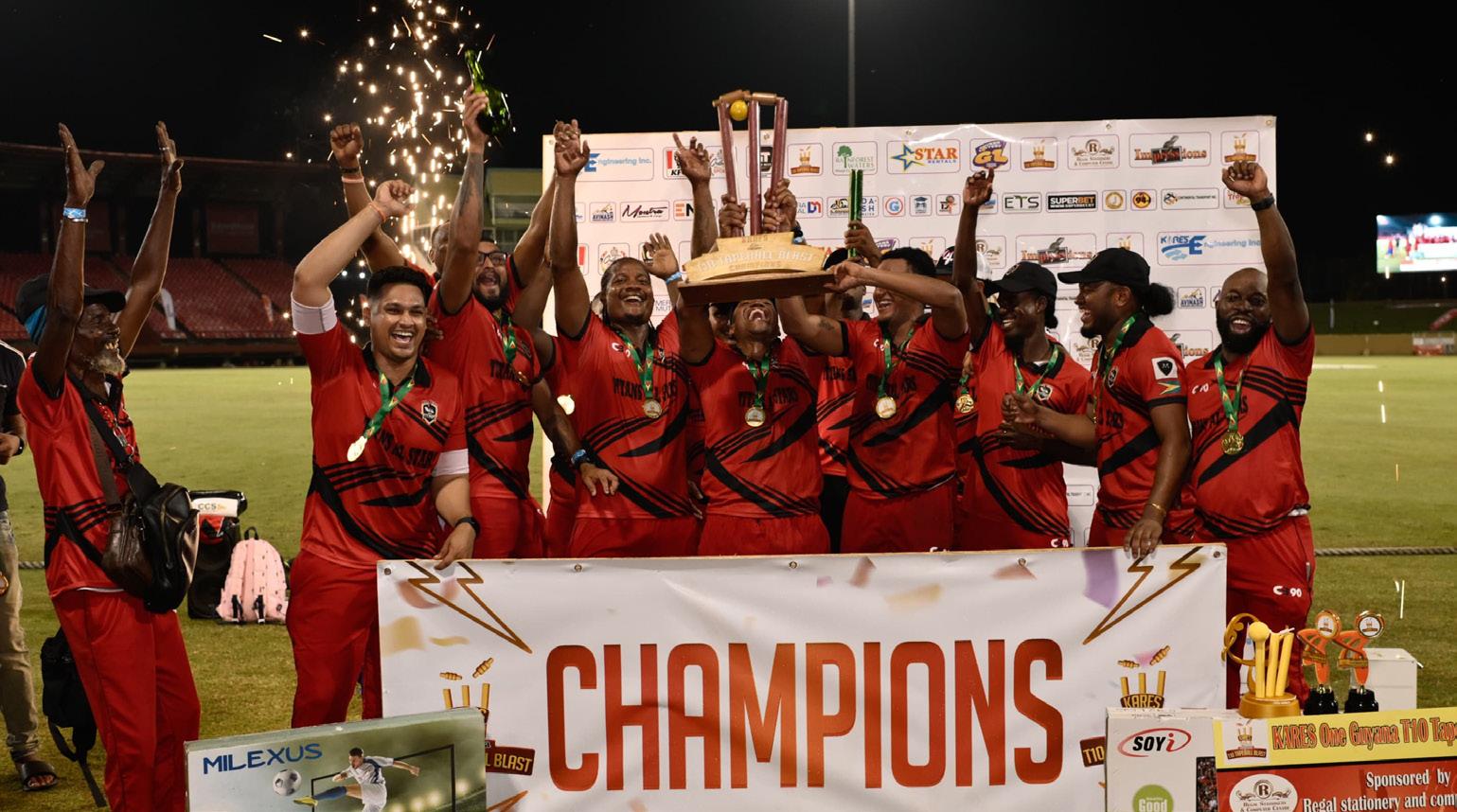
by the experienced duo of Keemo Paul (2 for 12) and Paul Wintz (2 for 12), who collectively sealed the title for Titans.
For the second year running, Sampson won the Most Valuable Player prize, a motorbike, and $150,000, all compliments of Regal Stationery and Computer Centre. He also received $100,000, a trophy, and a television for taking 13 wickets in the tournament.
Additionally, he received $75,000 from businessman Mario Moonsammy for being the Player of the final and a trophy from Trophy Stall.
Yusuf scored the most runs, 282, and Regal awarded him $100,000, a trophy,
and a television. Sampson finished second with 237 runs.
Trevor Benn (Most Economical) and Trinidadian Joshua James (Super Strike rate) also got $35,000 each. As champions, the Titans took home $2M ($1.7M at the national final and $300,000 at the zone final), while Eccles received $1M ($700,000 at the national final and $300,000 at the zone final).
In the first semi-final, Titans All-Stars defeated Mahdia (Movements Family) by 51 runs. Titans posted 140 for 6, led by Kemol Savory (39), Akshaya Persaud (36*), Christopher Barnwell (19), and Clinton Pestano (15*).
Mahdia's chase faltered, as they were restricted to 89 for 9 despite contributions from Ricardo Adams (33 off 17) and Nizam Khan (24). Leon Johnson (2 for 7) and Sampson (2 for 9) shared the wickets for Titans.
The second semi-final was a low-scoring thriller, with Eccles All-Stars narrowly defending 82 against Montra Jaguars. Eccles chased down the target of 83 with just two balls to spare, finishing on 83 for 6. Quazim Yusuf (29) and Akeim Vieira (20) were the principal scorers. Devendra Latchman (2 for 5) and Raymond Perez (2 for 8) kept Montra in the hunt until the final over.
Earlier, Anthony Bram-
LAUDERHILL, Florida, (CMC) – Openers Sahibzada Farhan and Saim Ayub both struck half centuries to set up Pakistan’s 13run victory over the West Indies and seal a 2-1 win in their T20I series on Sunday.
Player-of-the-Match Farhan scored 74, while Ayub made 66, to set the foundation for their side’s formidable total of 189 for four in 20 overs after they won the toss and chose to bat at Broward County Stadium.
Alick Athanaze and Sherfane Rutherford also hit half centuries for the West Indies, who at one point seemed on track for victory before losing the plot to end on 176 for six.
The result marked the seventh consecutive time, dating back to 2013, that Pakistan defeated the West Indies in a bilateral T20I series.
The last time West Indies emerged victorious in a T20I series over the South Asian country was in 2011.
Pakistan was given a dream start by Farhan and Ayub, with the two sharing an opening stand of 138, which frustrated the West Indies’ bowlers and gave them the perfect launching pad to post the highest total of the three-match series.
The pair started cautiously, with Farhan hitting the first boundary in the third over by slog sweeping Akeal

Hosein for six. They were solid if not spectacular, and by the end of the power play Pakistan was 47 without loss and West Indies wouldn’t have been too
worried at the halfway mark having restricted them to 82.
Farhan was the first to his half century, which he brought up off 34 balls with a
ble (32) laid the foundation for Montra, but wickets fell steadily, with Kevon Anderson's 17 being the next-best score.
FL Sport is now turning its attention to the possibility of hosting a Caribbean tournament in 2026, which would see the top teams from Guyana facing their counterparts from across the region.
The Kares One Guyana T10 Tapeball Blast received extensive support from a wide array of sponsors: Kares Engineering Inc, the Office of the President, the Ministry of Culture, Youth and Sport, KFC Guyana, Star Rentals, Banks DIH, ENet,
Guyana Lottery Company, Regal Stationery and Computer Centre, Trophy Stall, Impressions, Avinash Contracting and Scrap Metal, B.M Soat, Shawn’s Mini Mart, Giftland Group of Companies, Kris Jagdeo Construction Company, Montra Restaurant & Lounge, Windsor Estates, The New Doctor’s Clinic, GuyOil, ANSA McAL, SuperBet Guyana, Digital Technology, Camille’s Academy, Navin and Sons Construction, First Change Builders Inc, Jacobs Jewellery, Demerara Mutual Life Insurance, Continental Transportation, and Environmental & Technical Solutions.
DEN AMSTEL Football Club’s long awaited return to their home fortress in the village of Den Amstel was a resounding success as the West Coast Demerara side kicked off the second half of season 7 of the Elite League with a stunning victory over league debutant Mainstay Goldstar.
Mainstay Goldstar who entered the league this year, has had a brutal journey with double digit losses, they suffered another yet heavy defeat losing 12-1 on Sunday.
Delon Lanferman as is always the case when representing his home village was imperious as he registered four goals in a lopsided affair





A DANK grey morning in South London, a packed crowd at the Kia Oval, and 53 of the most extraordinary deliveries in Testmatch history, all of which culminated in the inevitable, indefatigable redemption of Mohammed Siraj, whose gut-busting five-wicket haul trumped a very different, but every bit as heroic, intercession from England's incapacitated Chris Woakes, in one of the greatest climaxes in all of Test history.
(Scores: India 224 (Nair 57, Atkinson 5-33) and 396 (Jaiswal 118, Tongue 5-125) beat England 247 (Crawley 64, Brook 53, Prasidh 4-62, Siraj 4-84) and 367 (Brook 111, Root 105, Duckett 54, Prasidh 4-126, Siraj 5-104) by six runs.
Twenty years ago, on this very day, the legendary Edgbaston Ashes Test of 2005 got underway, but even that match's breathless two-run finish paled compared to the agonising drama that spanned a solitary hour of play of this, the 25th and final day of another all-timer of a Test series.
By the end of it all, India had landed their closest victory in Test history, by six runs. Their players were doing a lap of honour in front of a sea of their jubilant fans, grins beaming out from their battle-weary bodies, safe in the knowledge that they had earned every drop of the acclaim.
This final act had been forced upon the series by the chaotic thunderstorm that had ended the fourth day early, arguably to England's benefit in that moment, given the hot vein of form that Siraj had locat-
ed to drag the contest, kicking and screaming back in India's direction after Harry Brook and Joe Root had, at one stage, threatened to rampage to their target of 374.
With one last burst of Lee Fortis' heavy roller before play, and with the potential for Siraj and his crucial sidekick Prasidh Krishna to resume with an adrenaline hangover, England were arguably favourites when play resumed, with 35 runs needed and three (and a half) wickets in hand. When Jamie Overton duly cracked two fours from Prasidh's first two balls of the day - the latter, admittedly, very streakily past his leg stump - that equation was in danger of being settled in a matter of minutes.
Siraj, however, was not letting this one slip. Of all the extraordinary moments in the course of five breathless Tests, nothing had threatened to have a more lasting legacy than his own crestfallen face-palm at deep fine leg on the fourth afternoon, in the moment that he stepped on the boundary rope to turn a regulation top-edge from Brook into a momentum-shifting six.
Coupled with his cruel luck with the bat in a similarly tense finale at Lord's, it was an error that had drawn Siraj's heart ever more fervently onto his sleeve. It had been his mission to make amends every step of the way of his exhausting 30.1-over effort, and the deliverance would prove to be exquisite.
The winning moment came with a pinpoint yorker to uproot Gus Atkinson's off stump, as he swung lustily once more - knowing that Woakes, his left arm in a sling after
dislocating his shoulder in the field, could not be asked to do more than just be there. However, that snapshot hardly scratches the surface of the drama he ignited.
Siraj's final act began with 27 runs left to defend, and England's most likely matchwinner, Jamie Smith, in his sights on 2 not out from 17 balls. Right from the getgo, he located that crucial old-ball movement, and got his pace cranked up into the high-80s in the process. But, with Smith inevitably itching to get this done quickly - as is the Bazball ethos - Siraj cunningly kept his line wide, forcing the batter to come looking for his drives, and duly hitting paydirt with his third ball of the day - a palpable nick through to Dhruv Jurel that the umpires, under extraordinary pressure themselves, took upstairs to double-check.
In an instant, the momentum lurched violently in India's direction, and Atkinson, the new man, might have gone first ball as he was squared up by Siraj's tighter line only for the ball to reach KL Rahul on the half-volley at second slip. At the other end, Overton's long levers - which have attracted the interest of England's white-ball teams in recent years - were stymied by six men back on the rope, one of whom, Ravindra Jadeja, pulled off a tigerish stop at deep cover to save a priceless boundary as Atkinson drove firmly off Prasidh.
Siraj, however, was still the main man. With the old ball still talking, a big inswinger crunched into Overton's pad as he was pinned on the crease, and it was the vorac-
ity of the appeal that prised the crucial decision. Umpire Dharmasena waited an eternity before deciding that the appeal was worthy, and Overton's desperate review duly confirmed that the ball would have been clipping leg stump Moments later, umpire Ahsan Raza was similarly convinced by the inswinger, as Josh Tongue was pinned by Prasidh, but this time his review was clearly shown to be missing leg. In his next over, however, Prasidh didn't need the umpire's assistance. A piledriver of a yorker burst through Tongue's defences for a 12-ball duck, and at 357 for 9, the die was cast for an extraordinary contest to receive an immortal finale.
This was a match that burgled plotlines from a host of immortal predecessors - not least Trent Boult's boundary-catch-that-wasn't in the 2019 World Cup final. But now, 40 minutes into the day's play, out strode Woakes from the pavilion, one arm completely encased by a sling beneath his jumper, charged with the task of hanging in there as best he could, as England's last man Atkinson attempted to hack away the 17 runs still needed for victory.
Sixty-two years have elapsed since Colin Cowdrey did likewise at Lord's in 1963, returning to the crease with a broken arm, with England six runs from victory and with one wicket still standing. In those less chaotic days, David Allen opted not to go for broke against Wes Hall with two balls of the match to come, and Cowdrey was not required to do more than lean on his bat. Woakes, on the other hand, had a significant-
ly more torrid role in store.
The onus, though, was on Atkinson to score the runs. Two balls into Siraj's next over, he connected magnificently with a launch across the line, as Akash Deep - in off the rope at deep midwicket - could only palm the ball across the rope as he leapt in vain to intercept. Three air-shots ensued, whereupon - from the last ball of the over - Woakes hurtled off for a bye to the keeper, his arm bouncing out of his sling in the process, leaving him wincing in agony as umpire Raza helped to swaddle him back into position.
There was no respite, however. "Two!" was Atkinson's instant call one ball later, as he found rare space in the deep off Prasidh to take the target into single figures. And though he could not make further inroads from the next four balls, the sixth was a gift, tight and full on the stumps, and a calm nudge to mid-on to keep the strike once more, and take England to within one blow of tying the scores.
Siraj, however, wasn't letting this cause slip now. In, he hurtled for one final effort ball. Back went Atkinson's off stump as he swung for the hills once again. Out came Siraj's "siu" celebration as his teammates swamped him in adulation. Off went the celebrations all across a nation that had no doubt come to a standstill on an otherwise nondescript Monday afternoon. So ended one of the most breathless hours ever witnessed in 148 years and 2,598 Tests. And one of the most compelling series in living memory. (ESPN Cricinfo)